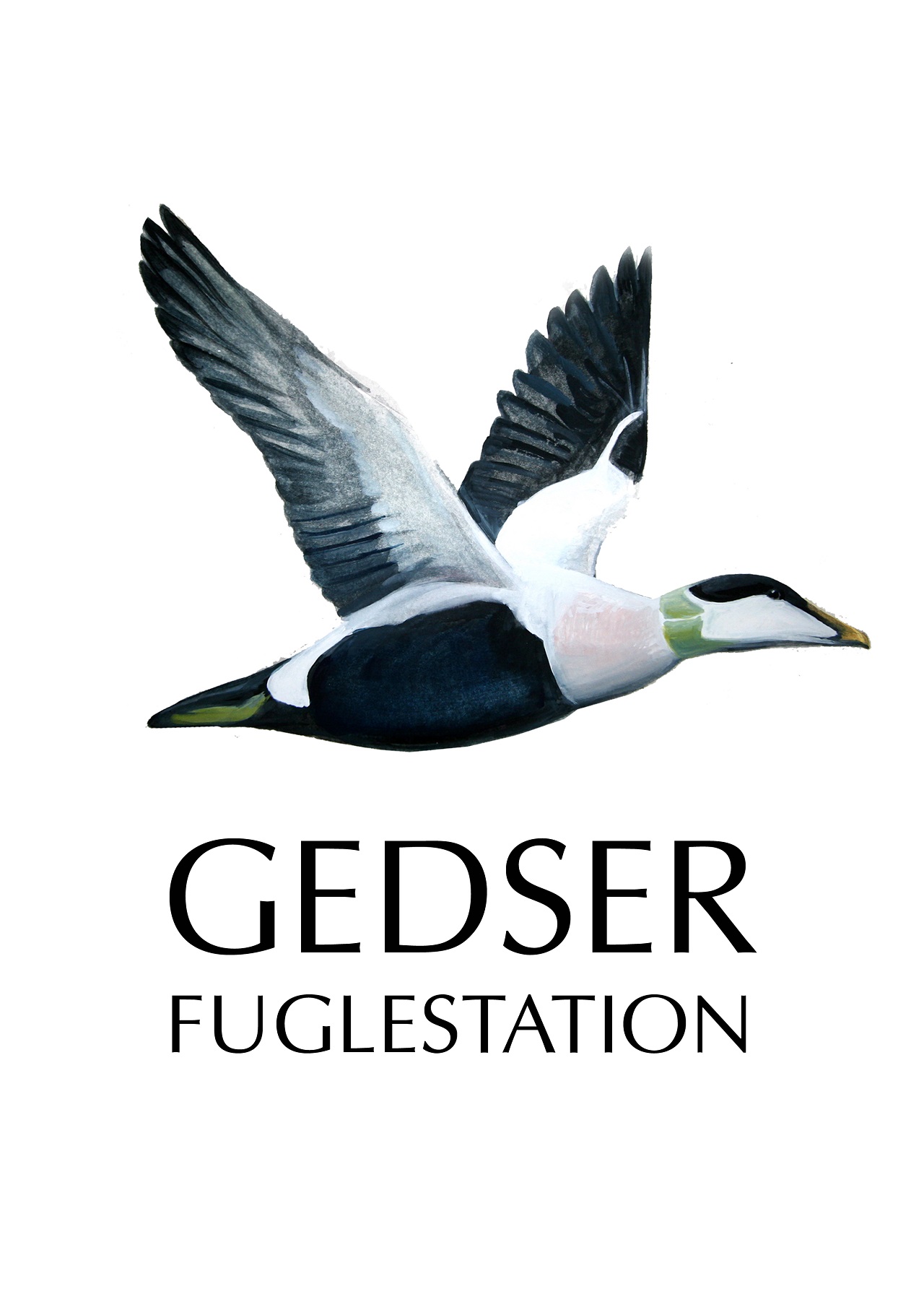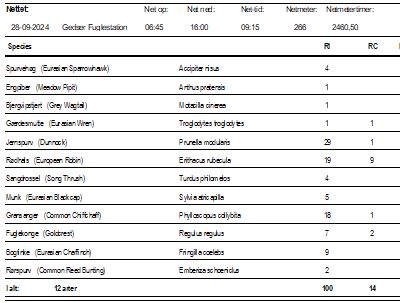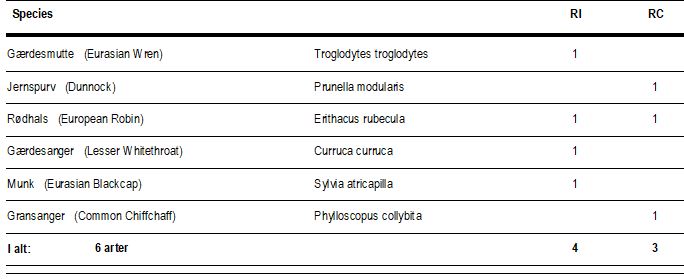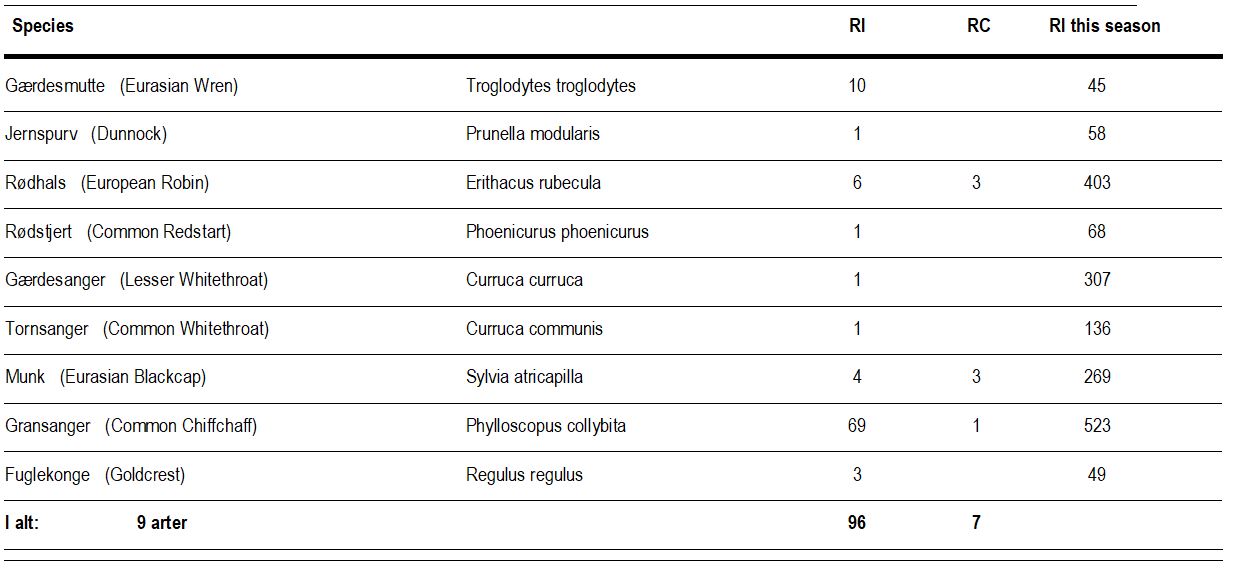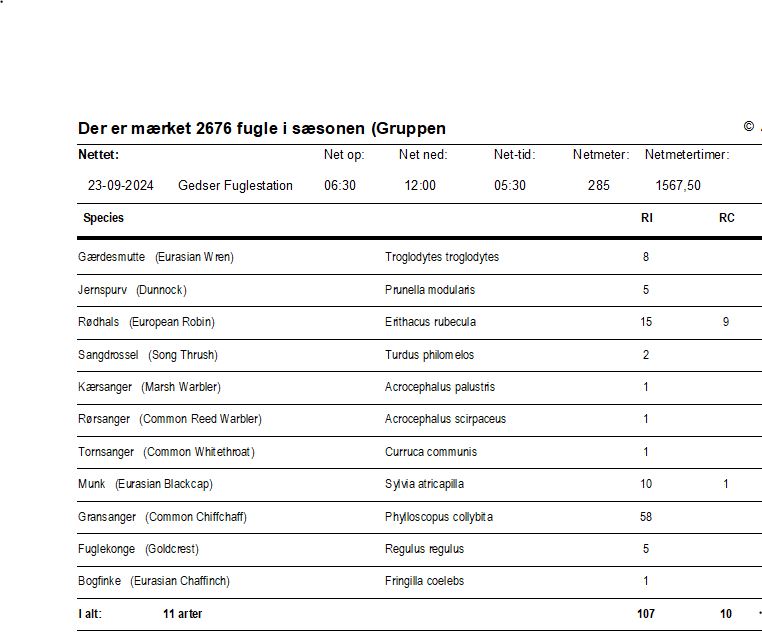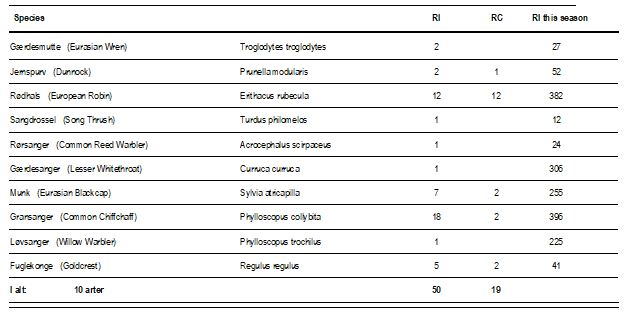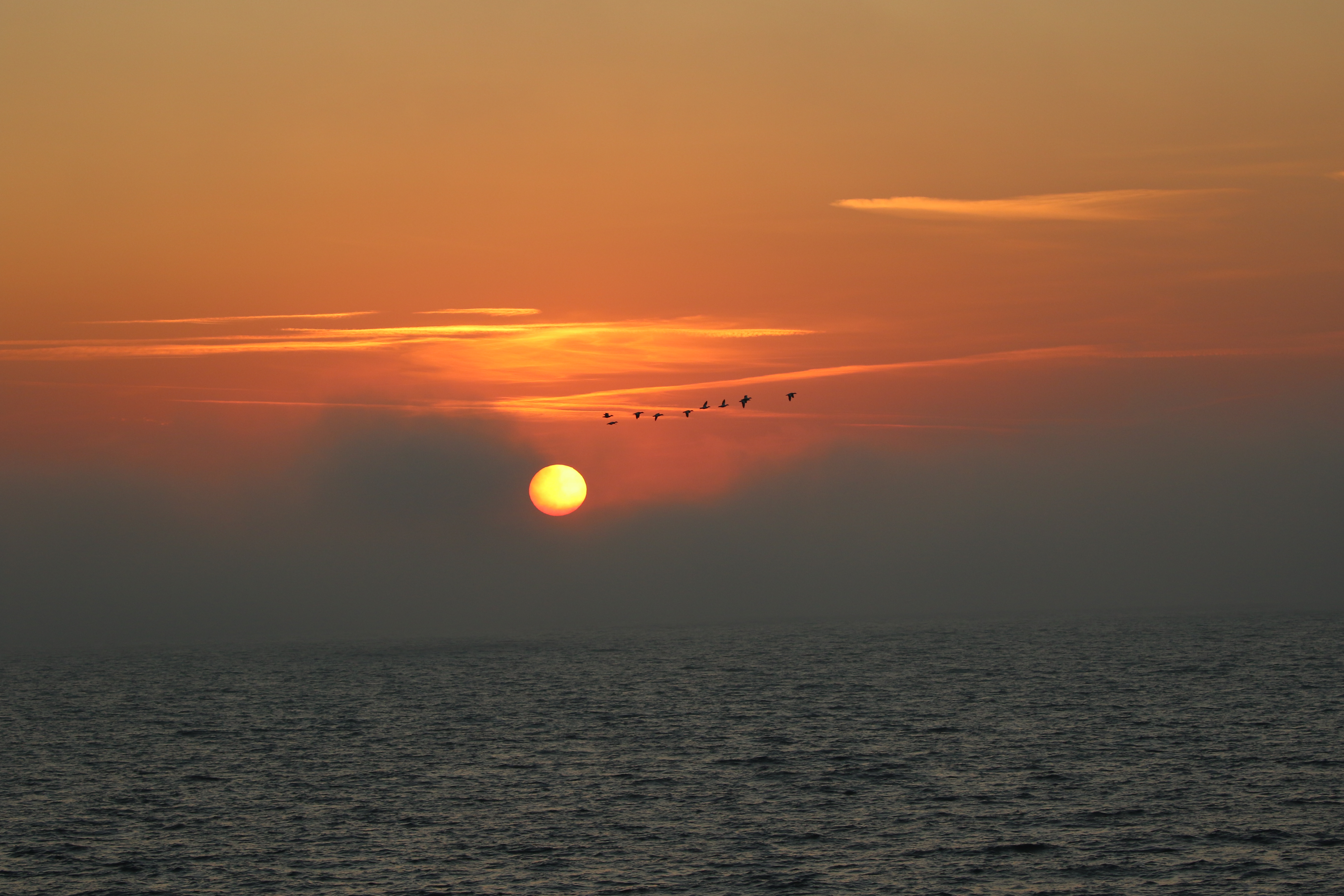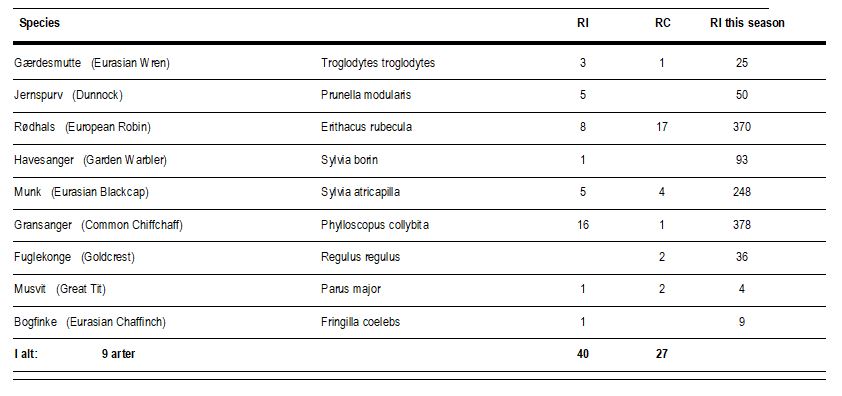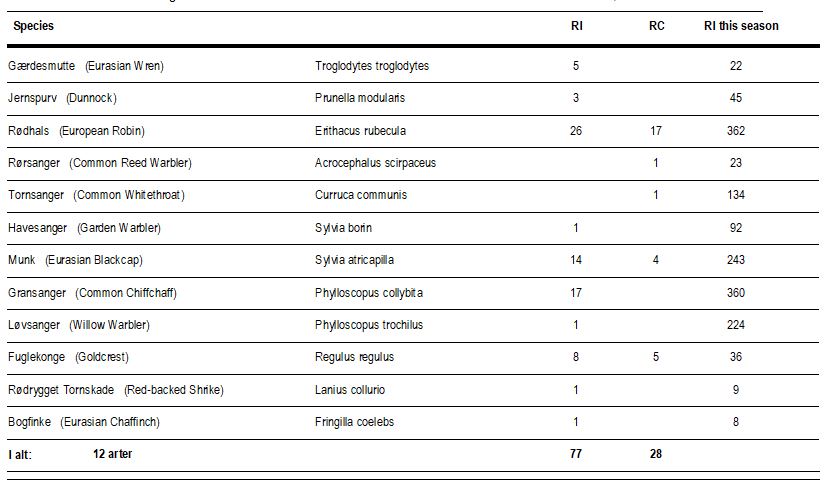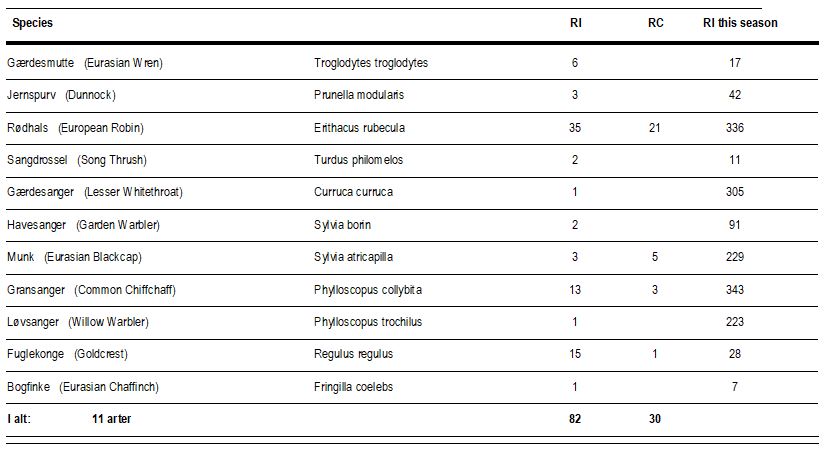Gedser Fuglestation Blog
Her på Gedser Fuglestations blog bringes korte nyheder i dagbogsformat om hændelser på fuglestationen.
Simple bird love
Ringmærkningen: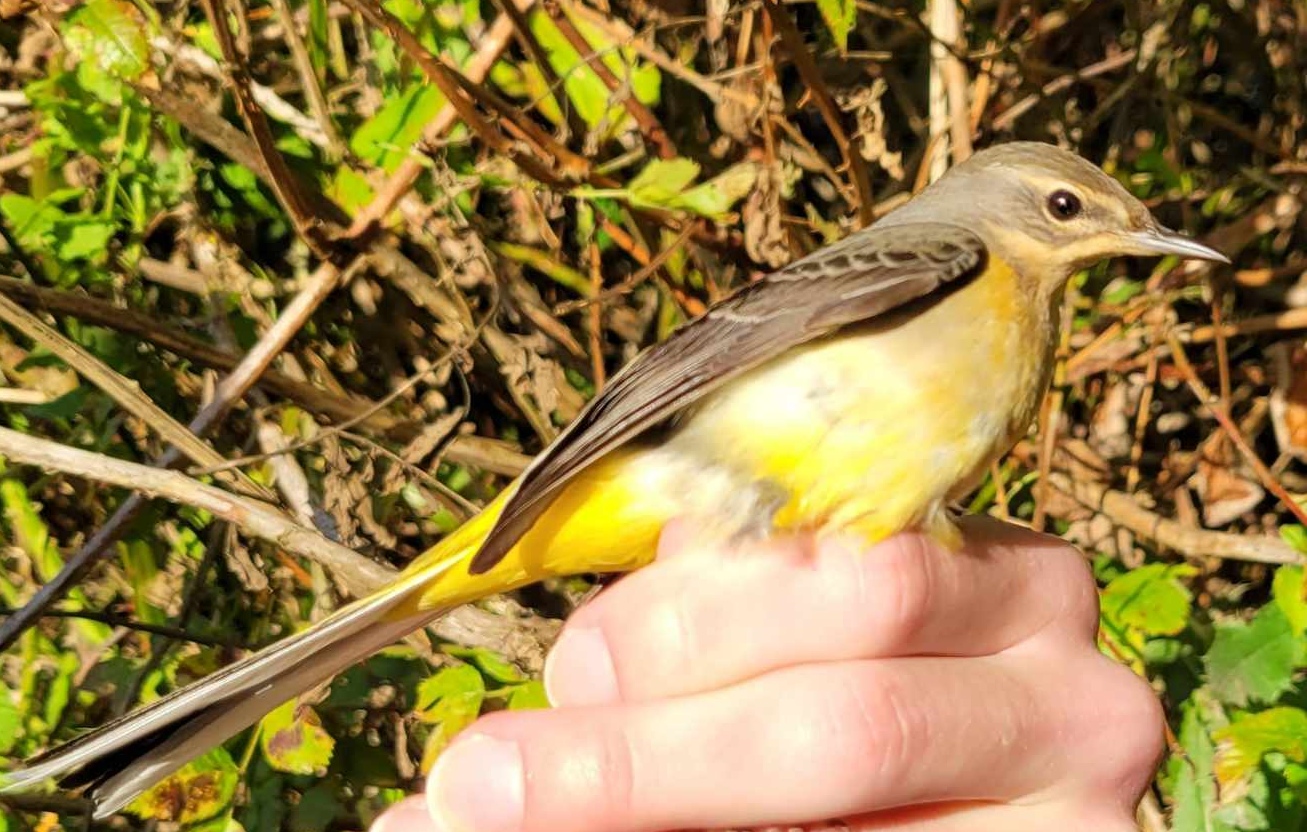
Dagens bedste: Bjergvipstjert
Igen en travl dag med 9 forventningsfulde kursister og 4 instruktører, samt besøg af af Jesper Johannes fra Museet.
Vi håbede på at få en god portion fugle oven på de 2 sidste dages dårligt fangstvejr og det lykkedes heldigvis.
En lang og dog hyggelig dag, hvor vi holdt nettene åbne helt til kl. 16. Men så var det også ved at være udsolgt på alle hylder og bloggen her blev lavet i al hast efter alle andre var gået i seng.
Og det vil jeg så også nu .
Fangster:
Migration count at Gedser Odde
by Lara W
Dawn came with exquisite colours and cloud formations, looking rather like a cityscape skyline along the horizon. A westerly wind brought 45 species across the point, totalling 1,792 individual birds, including quite a variety of passerines and raptors. Several gull species are now migrating in greater numbers too, although fewer and smaller flocks of duck were spotted in comparison to the previous week.
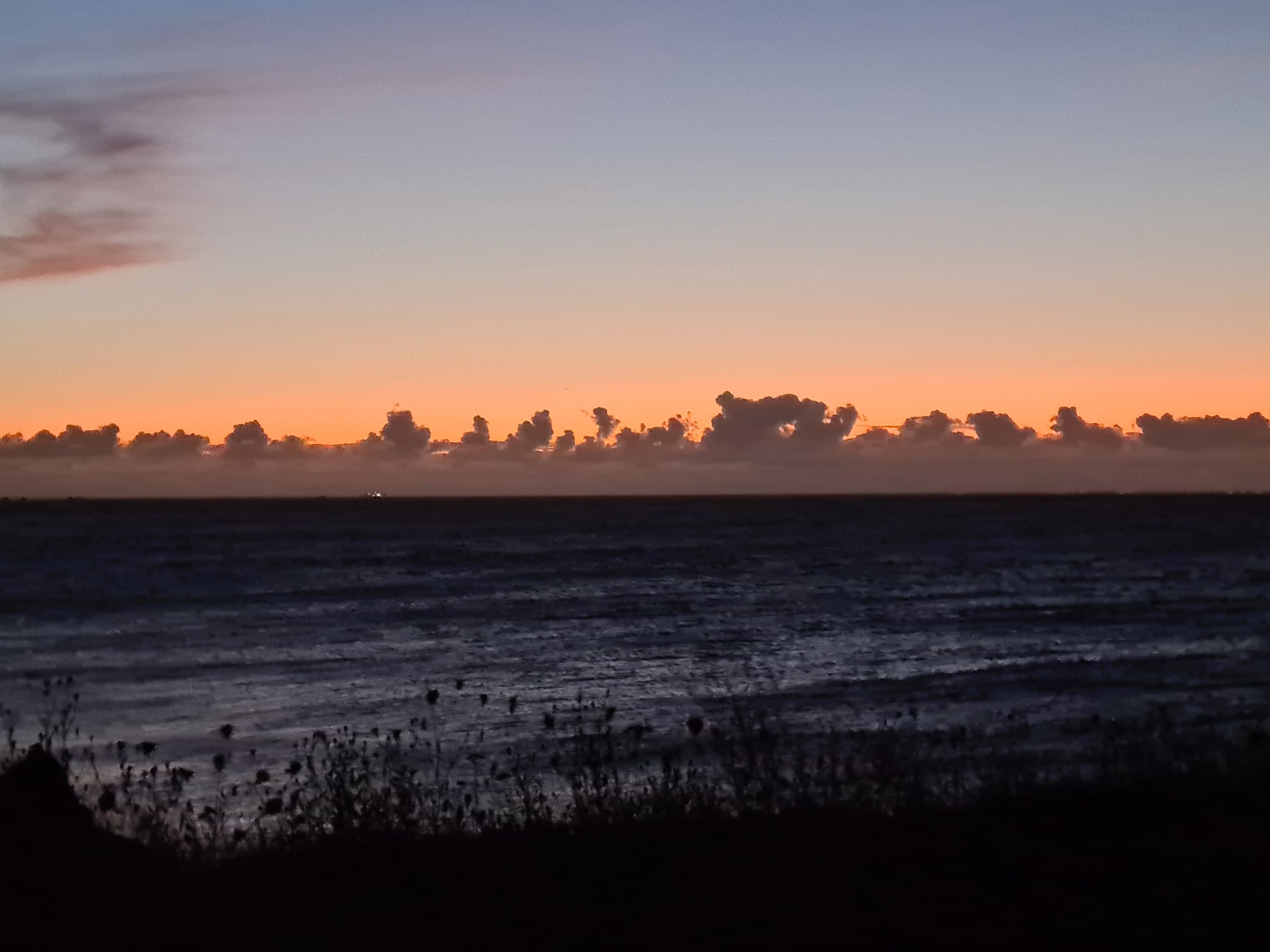
Photo credit: LAH
Of the passerines, in some cases, quite a number were counted going north as well as flying south. For instance, 15 Meadow pipit/Engpiber (Anthus pratensis) flew south in comparison to 85 north, 90 Chaffinch/Bogfinke (Fringilla coelebs) flew south and 65 north, and 26 Reed bunting/Rørspurv (Emberiza schoeniclus) flew south to 42 north. As mentioned in a previous blog post (“Day of the Scoter” from 15.09.2024), this could be due to the insistent need within the avian brain at this time of year to migrate, despite the wind direction forcing birds to fly off course. Other passerines counted today which were of note were 8 Song thrush/Sangdrossel (Turdus philomelos), 17 Starling/Stær (Sturnus vulgaris), 49 Siskin/Grønsisken (Spinus spinus), and a single Redwing/Vindrossel (Turdus iliacus). Redwings are truly quite beautiful birds, sporting a lighter build than many others within the thrush family, with a strong pale supercilium (eyebrow marking), and soft rufous colouring underneath the wing across the armpit region. Any ringing readers will also appreciate this bird for being rather quieter in the hand than their much louder cousins (looking at you Song thrush)!
10 species of raptor were spotted today, including 6 Marsh Harrier/Rørhøg (Circus aeruginosus), 3 Hen Harrier/Blå Kærhøg (Circus cyaneus), 3 Osprey/Fiskeørn (Pandion haliaetus), and 16 Honey Buzzard/Hvepsevåge (Pernis apivorus). Around midmorning, a striking Black Kite/Sort Glente (Milvus migrans) was seen circling above the field in company with 3 Red Kite/Rød Glente (Milvus milvus), ensuring the drastic differences in plumage were clearly contrasted. Three White-tailed eagle/Havørn (Haliaeetus albicilla) were also spotted, 2 of these soaring high up in the clouds above the sea later in the afternoon. The first, a juvenile judging from the lack of white on the tail feathers, flapped patiently around the field behind the point in a rather dignified manner, pointedly ignoring the flock of stressed Hooded Crow/Gråkrage (Corvus cornix) that attempted to drive the much larger bird off. A rather entertaining view of interspecific behaviour.
Of the smaller raptors, 14 Kestrel/Tårnfalk (Falco tinnunculus), 3 Merlin/Dværgfalk (Falco columbarius), 47 Sparrowhawk/Spurvehøg (Accipiter nisus), and 2 Hobby/Lærkefalk (Falco subbuteo) were seen migrating. We were treated to a couple of occasions watching Merlin hunt passerines just off the coast, perhaps catching a few meals before attempting the crossing later in week. The speed and agility of these birds is wonderful to behold. Evolution is a continual process, and the infinitesimal mutations between generations making both the hunter and the hunted swifter, more dexterous, more sensorily advanced, is an exquisite battle of nature evident in any such observation. Having said this, later on in the afternoon, I found myself within two feet of a sparrowhawk who had jinxed around the corner and attempted to perch on the metal railing behind me. I was as surprised as he was…perhaps further sensory evolution is required!
Further out on the sea, we had the usual suspects, although in lower numbers than earlier in the week – 411 Common Eider/Ederfugl (Somateria mollissima), 325 Wigeon/Pibeand (Anas Penelope), 31 Pintail/Spidsand (Anas acuta), 49 Teal/Krikand (Anas crecca), and 41 Common scoter/Sortand (Melanitta nigra). Skimming above the waves, we were treated to 3 Arctic skua/Almindelig Kjove (Stercorarius parasiticus), one of which I managed to watch for quite some time as it approached the shore, eventually bullying a gull into dropping a fish in typical kleptoparasitic behaviour. A steady flow of Sandwich tern/Splitterne (Thalasseus sandvicensis) passed both south (80) and north (48), along with 43 Common gull/Stormmåge (Larus canus), 16 Herring gull/Sølvmåge (Larus argenteus), and 3 Little gull/Dværgmåge (Hydrocoloeus minutus). 2 Red-throated Diver/Rødstrubet Lom (Gavia stellata), 1 Red-necked Grebe/Gråstrubet Lappedykker (Podiceps grisegena), and 69 Cormorant/Skarv (Phalacrocorax carbo) were also counted. Although only 16 Dark-bellied Brent goose/ Knortegås (Branta bernicla) were spotted during the standard morning count period, several larger flocks were seen migrating later on in the afternoon.
All in all, a rather eventful day out on migration. Thank you to my good friends Larissa Britton, Mads Elley, LAH, and Gert for their companionship and expert birding skills, whilst simply appreciating these wonderful birds together.
At the station: Lara Winsloe, Larissa Britton, Vagn Lind og mange kursister og instruktører
Blæst og masser af folk
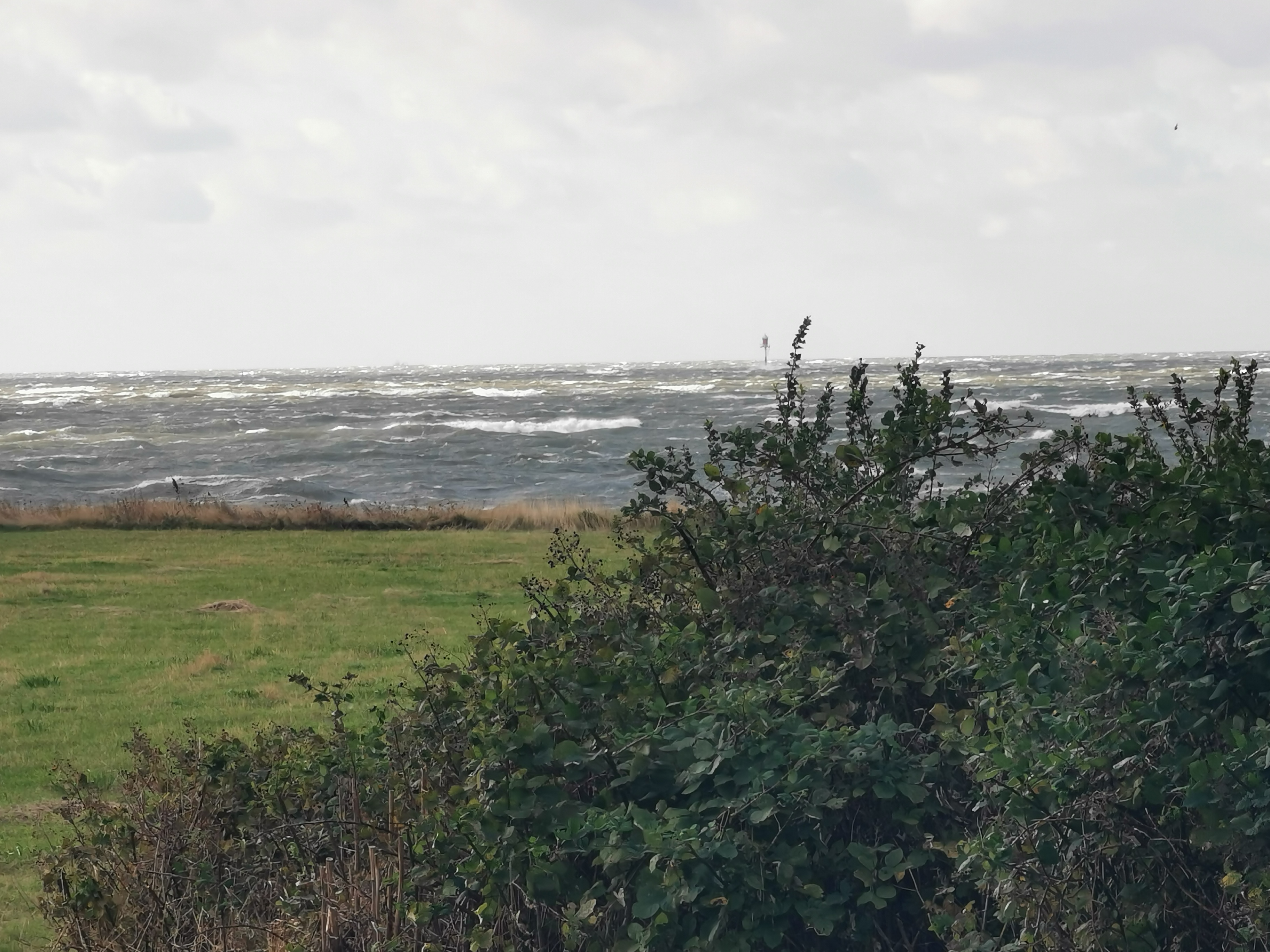
Det blev en meget stormfuld dag i Gedser i dag. 14-17 sekundmeter i middelvinden indbød egentlig ikke til ringmærkning, men vi fandt alligevel 92 meter net som stod i nogenlunde læ. Efter 3 timer valgte vi så at slutte for i dag. Vinden var bare for voldsom.
Ud på eftermiddagen dukkede de første kursister og instruktører til weekendens kursus for nystartede ringmærkere op. Huset summede af glade og forventningsfulde folk og vi havde en meget hyggelig eftermiddag og aften.
Mere om arrangementet i morgen
Dagens fangst
Sleep well, Snerresværmer
Migration at Gedser Odde
af Larissa Britton
A rainy and windy day at the tip this morning, so we took shelter in the Marine Station. There was still some good birding to be had. A Long-tailed Skua/Lille Kjove (Stercorarius longicaudus) was spotted flying out at sea, battling against the strong Southerly/S winds. A number of Swallow/Landsvale (Hirundo rustica) also braved these strong winds, venturing out over the sea. Two species of diver today: Black-throated/Sortstrubet Lom (Gavia arctica), and Red-throated/Rødstrubet Lom (Gavia stellata) with its slightly up-tilted bill. A flock of 6 Velvet Scoter/Fløjlsand (Melannita fusca) flew by close, so I could admire their white wing patches, the orange on the males' bills, and white spot around the eye.
During a period of little migration activity, I explored the corners of the Marine Station. To my delight, I found an (unfortunately dead) moth, in good enough condition to identify. This hawk-moth is a member of the Sphingidae family, and confirmed as Hyles gallii/Snerresværmer (also known as the Bedstraw hawk-moth and Galium sphinx). I found it in a spider web, below the Swallow/Landsvale nests within the Marine Station. A beautiful moth, I hope she rests in peace.
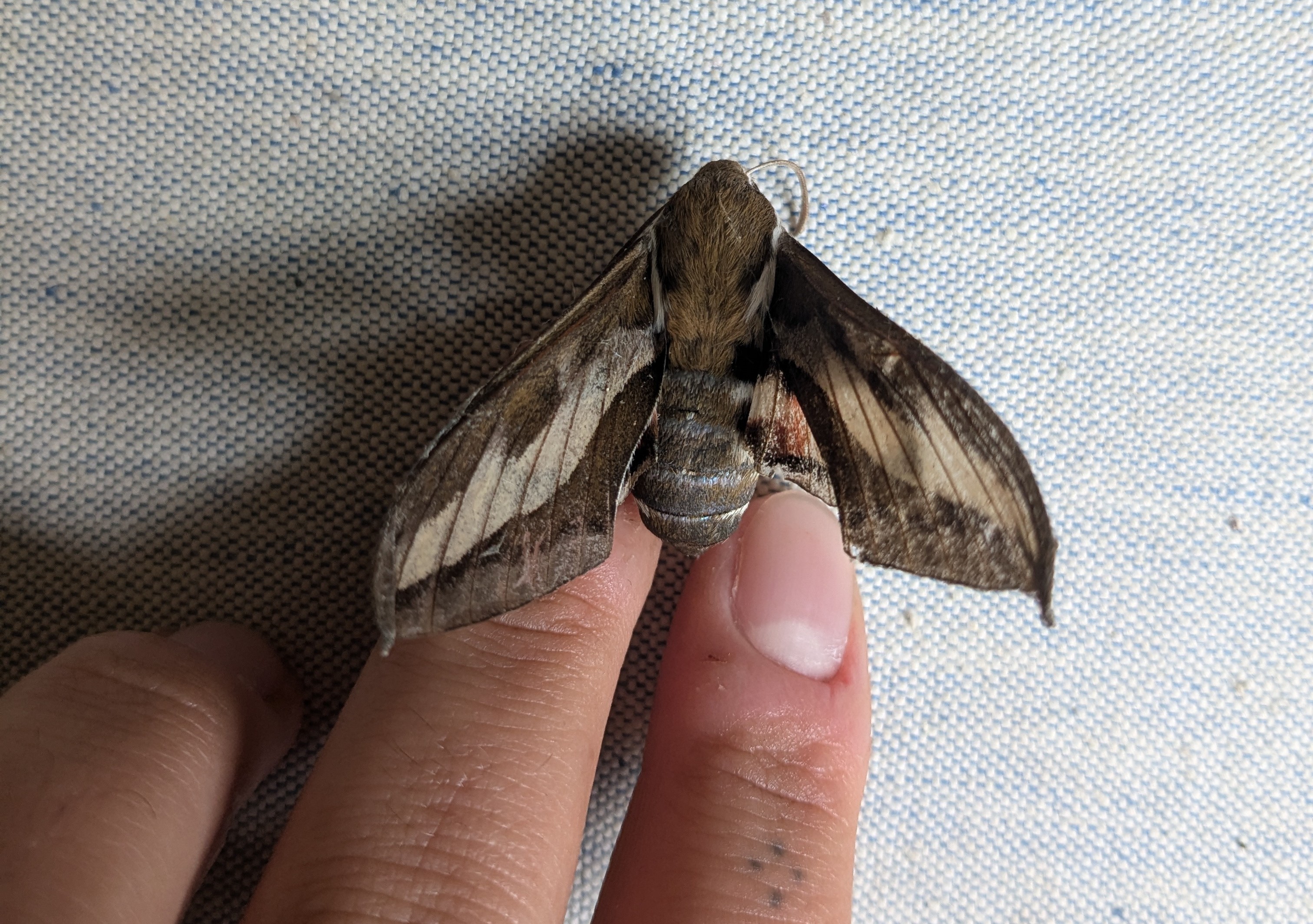
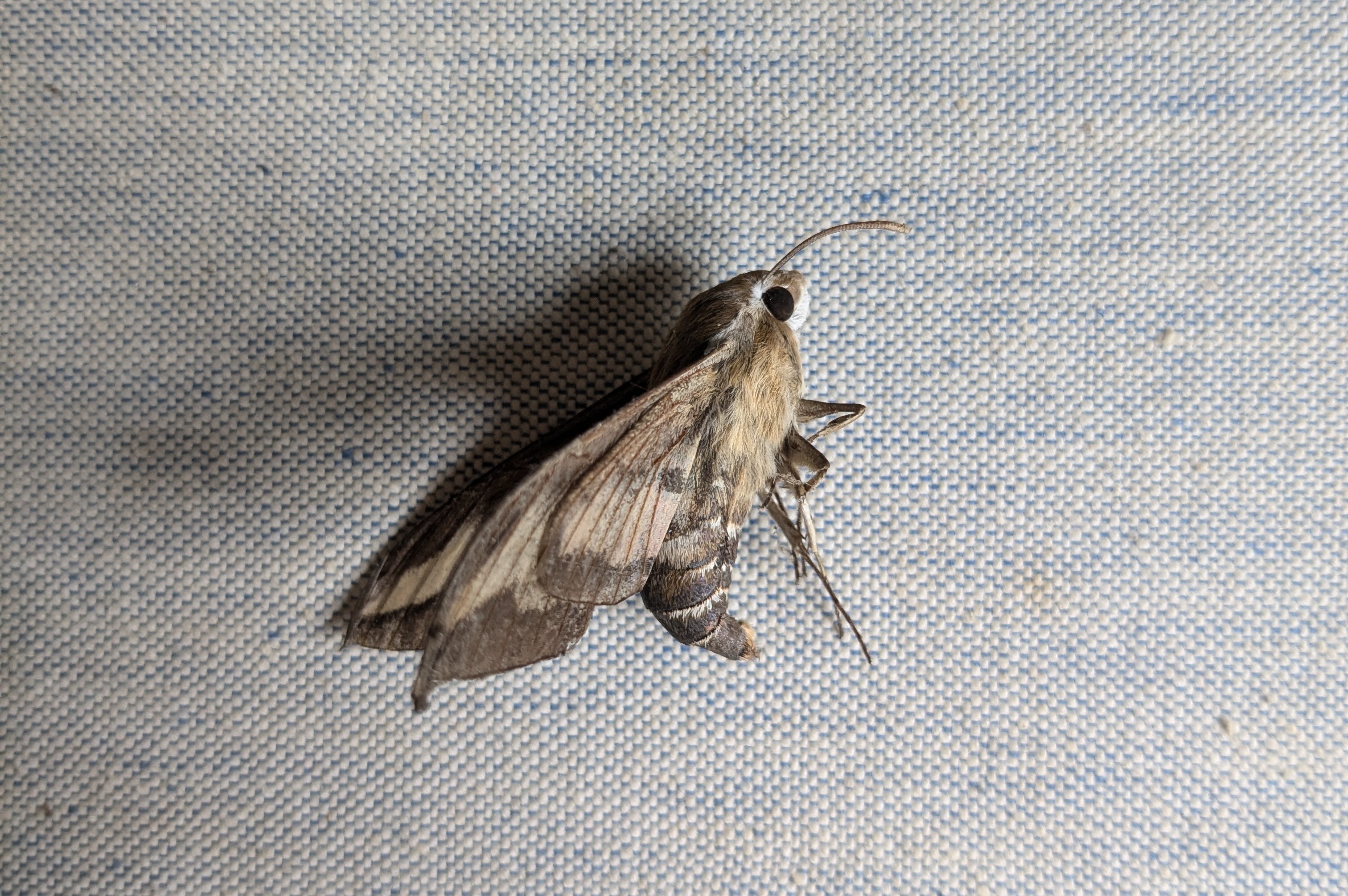
Hyles gallii photos af Larissa Britton
Ringing and Other Updates
by Lara W
Pouring rain meant that, unfortunately, no nets could be opened today. Luckily, the weather cleared up this afternoon, and I took a walk up the eastern coast along the beach. Highlights from the bird list were a couple of Sanderling/Sandløber (Calidris alba), Oystercatcher/Strandskade (Haematopus ostralegus), and Sandwich tern/Splitterne (Thalasseus sandvicensis), all between rain showers.
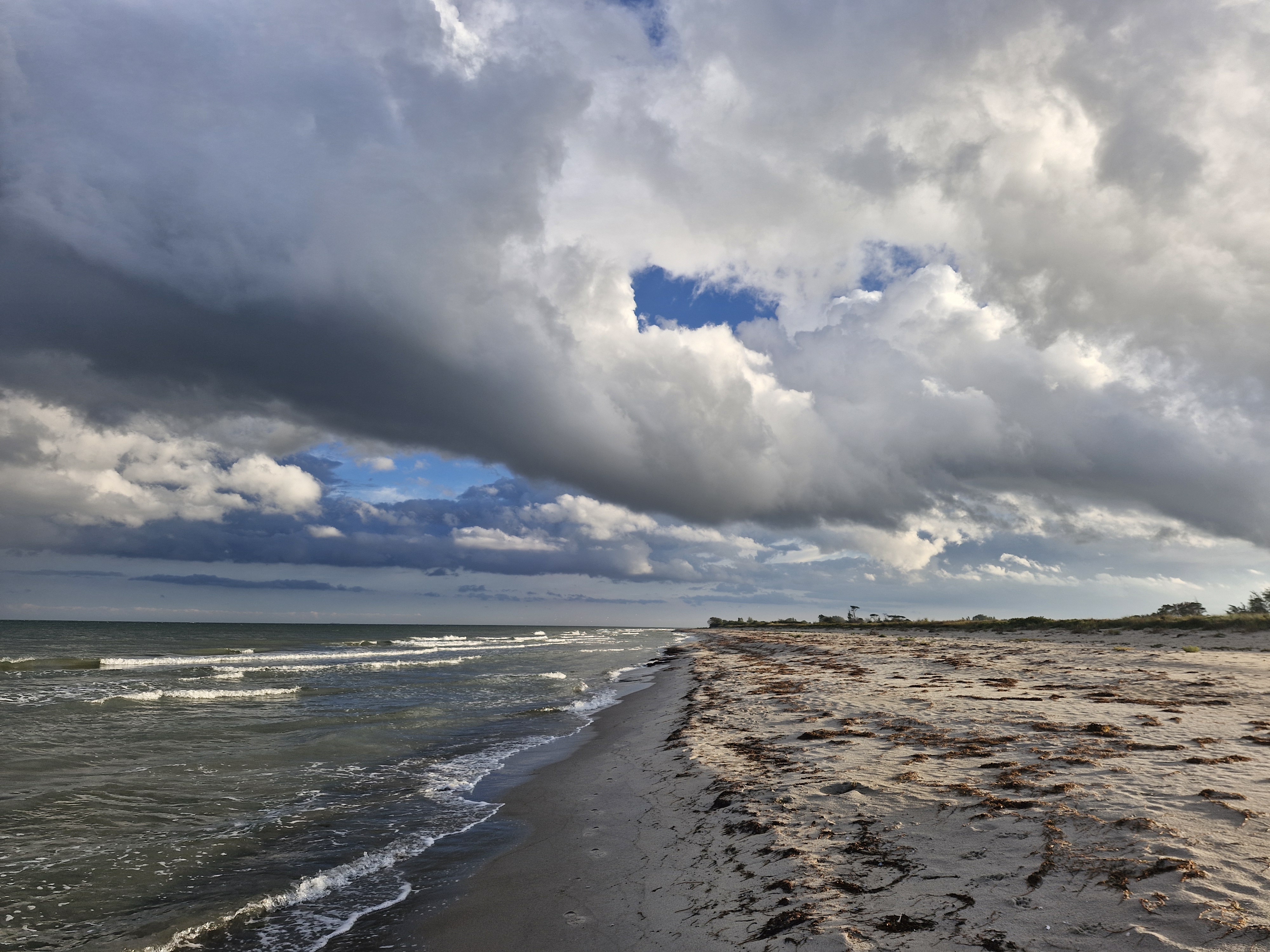
Just as I came back through the station garden, I spotted this little guy munching on the apples!
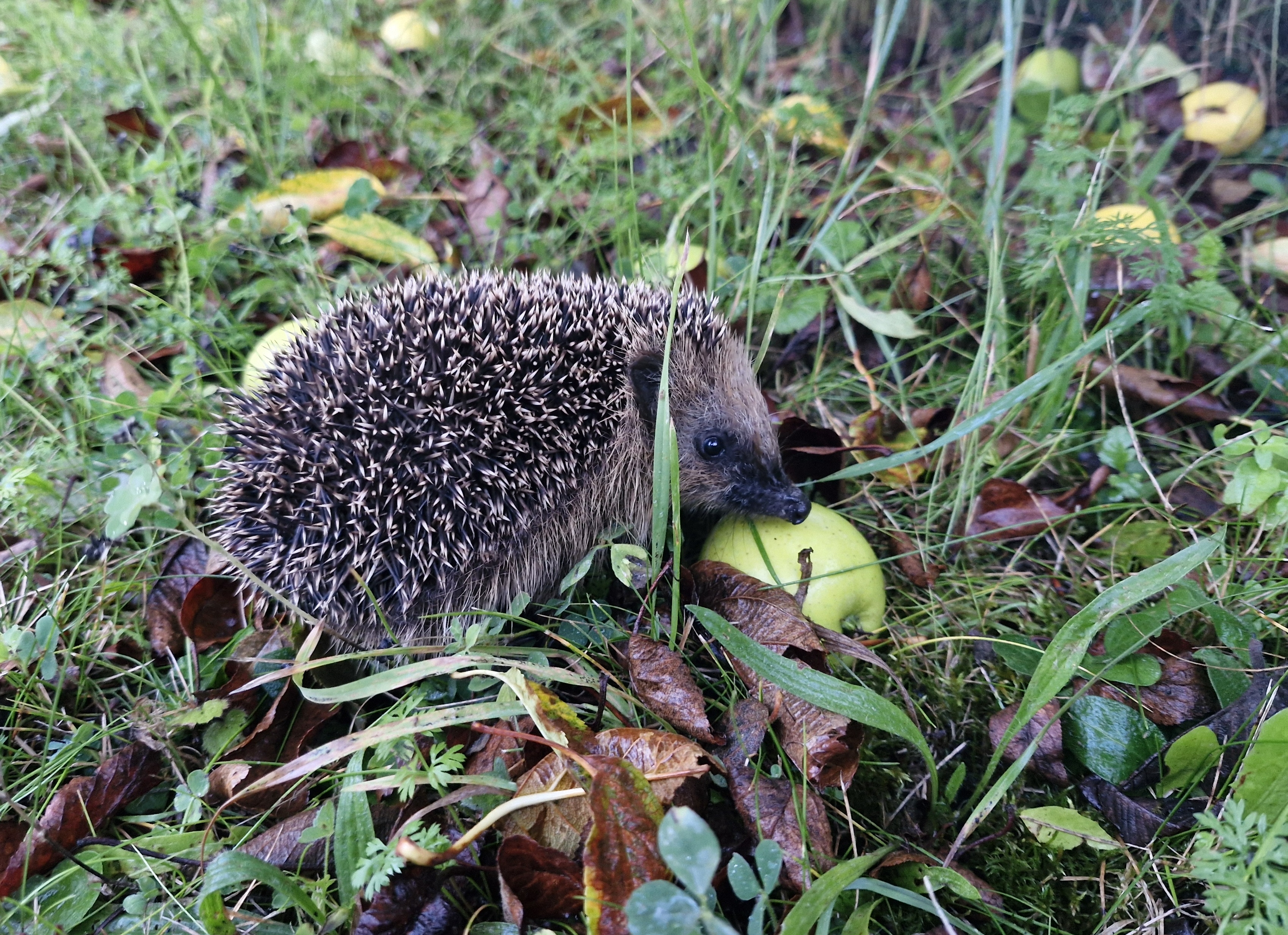
Hedgehog/Pindsvin (Erinaceus europeaeus) photo credits Lara W
People: Vagn Lind, Larissa Britton og Lara Winsloe
Det blæser en halv pelikan
Migration at Gedser Odde
by Larissa Britton:
It is raining now, so I am writing the blog with a cup of Fennel/Fennikel tea today, warm inside the station. There were strong Southerly winds this morning at the tip. Det blæser en halv pelikan (!)
No large flocks of duck today, only smaller groups typically comprised of one species. Over the course of the morning, around 30 Pintail/Spidsand (Anas acuta) were recorded. Though ducks were not in large numbers, we had a good show of raptors again today.
Three Osprey/Fiskeørn (Pandion haliaetus) were spotted, with all three flying South/S out at sea. A beautiful dark-feathered Marsh Harrier/Rørhøg (Circus aeruginosus) gave us good views over the water [this individual was not migrating]. Also over the water, a few Merlin/Dværgfalk (Falco columbarius) were seen. This is a small falcon that mostly feeds on small passerines which they chase in flight. We watched one individual flying very low to the water, possibly chasing Meadow Pipit/Engpiber (Anthus pratensis), or Swallow/Landsvale (Hirundo rustica) of which we saw many flying out at sea.
As for passerines, not many attempted the crossing due to the wind and large waves. However, flocks of Siskin/Grønsisken (Spinus spinus), Chaffinch/Bogfinke (Fringilla coelebs), White Wagtail/Hvid Vipstjert (Motacilla alba), and a single calling Tree Pipit/Skovpiber (Anthus trivialis), were noted.
Gert joined me later in the morning and spotted a White-tailed Sea Eagle/Havørn (Haliaeetus albicilla) flying not too distant - I still cannot get over the size of these birds! Soon after, a Hobby/Lærkefalk (Falco subbuteo) was spotted flying over the field.
I will be back here tomorrow with an update with what birds we see and hear at Gedser Odde.
Ringing at Gedser Fuglestation
by Lara W
Only a few birds today, which was not a complete surprise given the high south-westerly winds ripping through the station garden today. However, we were able to show a couple of visitors at least a few birds, pointing out how we ring them, what indicators we use for ageing and so on. We were lucky enough to catch a second calendar-year female Sparrowhawk/Spurvehøg (Accipiter nisus), however (see photos below). Females are quite a bit larger than males, and with a wing length of 232mm, we could safely say this was a female. For a notoriously fussy bird in the hand, this individual was thankfully quite passive and handled us as gently as we handled her. I am sure she quickly followed her instincts and carried on her southerly migration, complete with her new identification ring – perhaps even now she is passing over Germany!
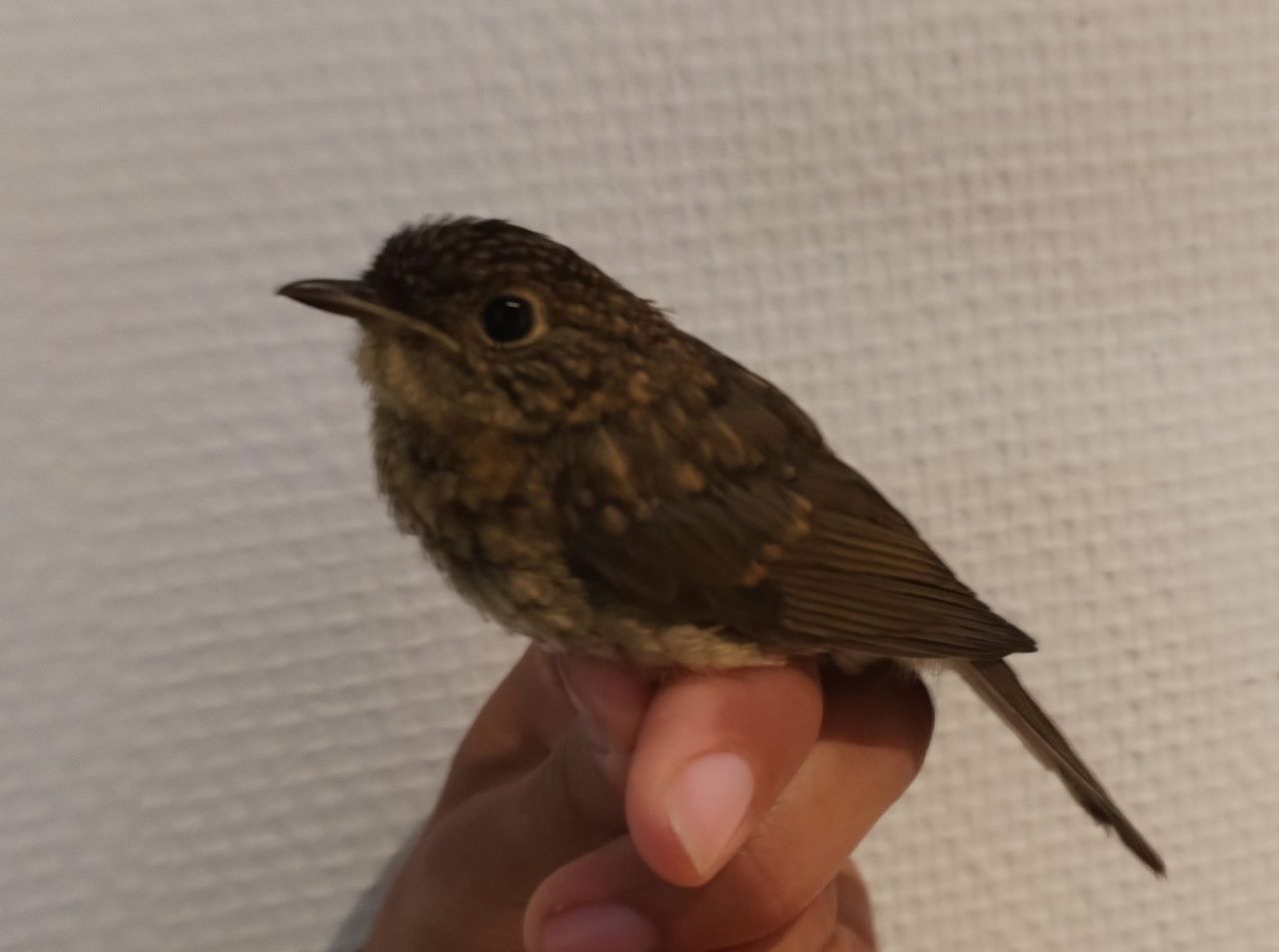
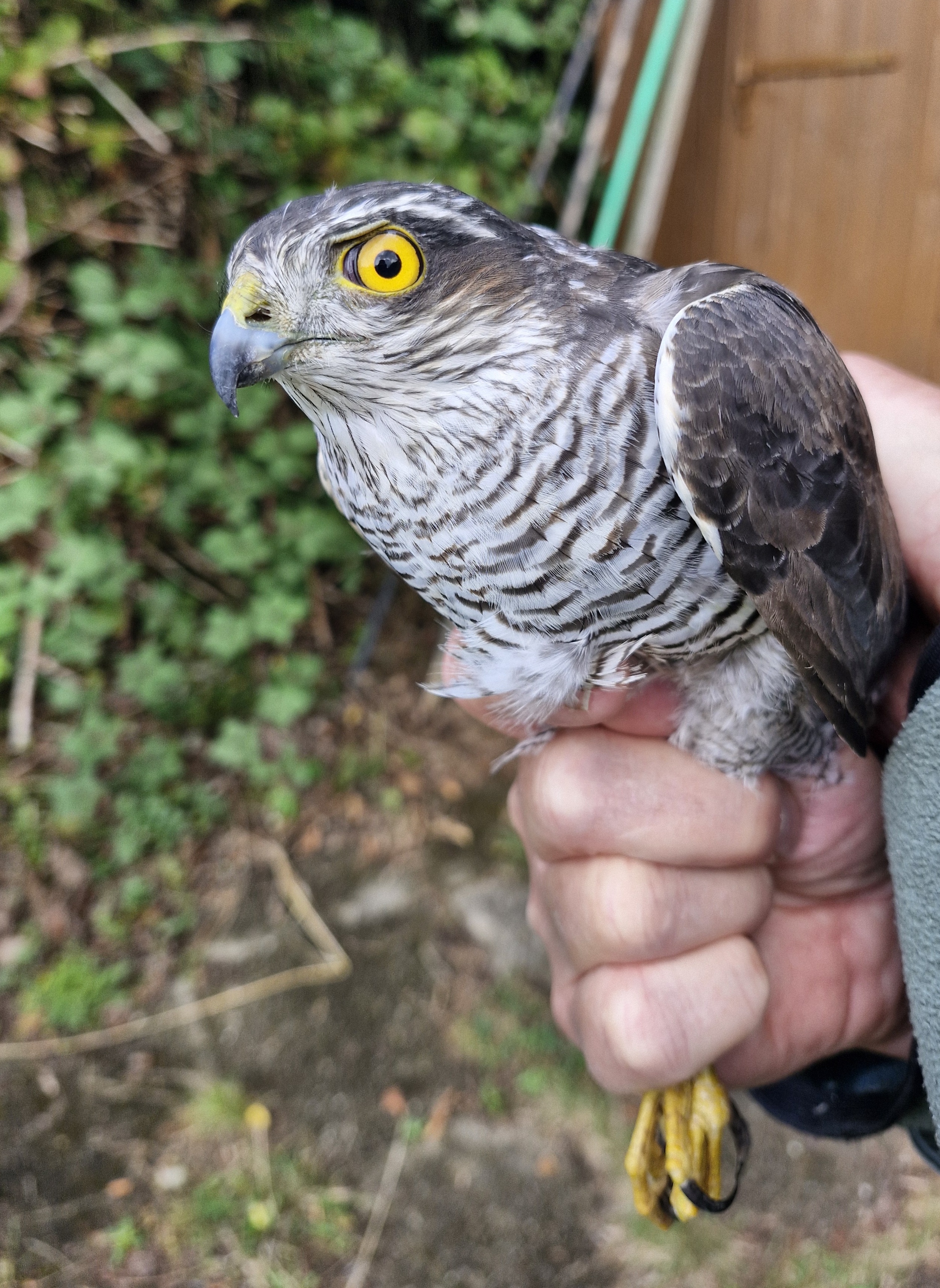
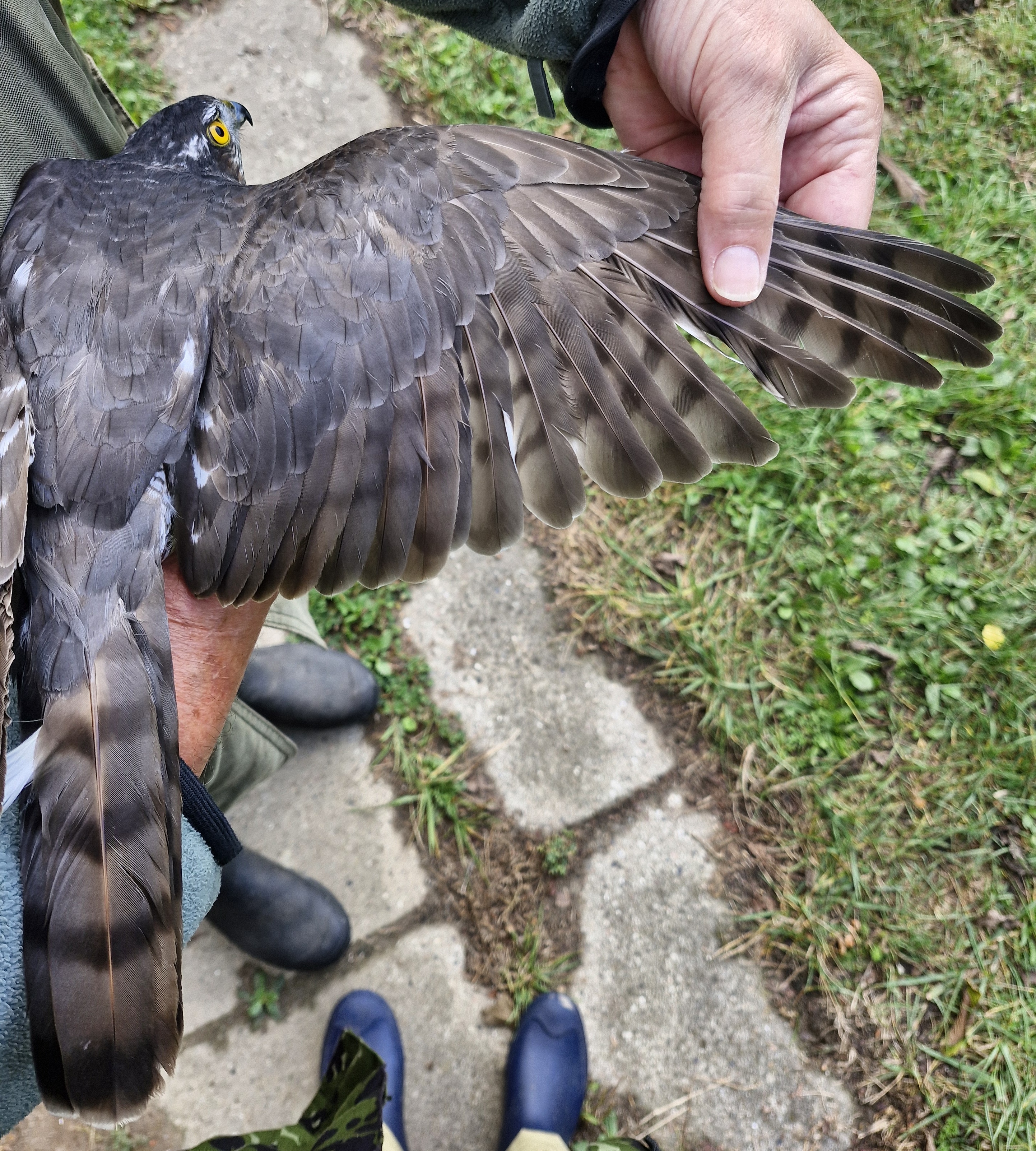
Sparrowhawk/Spurvehøg (Accipter nisus) Photo credit: Lara W.
People: Lara Winsloe, Larissa Britton, Vagn Lind
The Wrens "Gærdesmutte" are coming!
This morning, we need to count the recaptures too, to reach 100, we had 96 birds and 7 recaps, so another pretty good day. The number of recaps decreased significantly in the last two days, so bird migration is in full swing. Again, it was mainly Chiffchaffs “Gransanger” today and a deficient number of Robins “Rødhals”, just 6 new and three recaps but the abundancy of Wrens “Gærdesmutte” is going up, we had 10 new today, so it was the second most common species today. The weather was not perfect though, we needed to shut down the nets for half an hour but could still do standard time.
In the closing round, the rain started, we could just close in time. For the rest of the day, rain was heavily pouring from the sky.
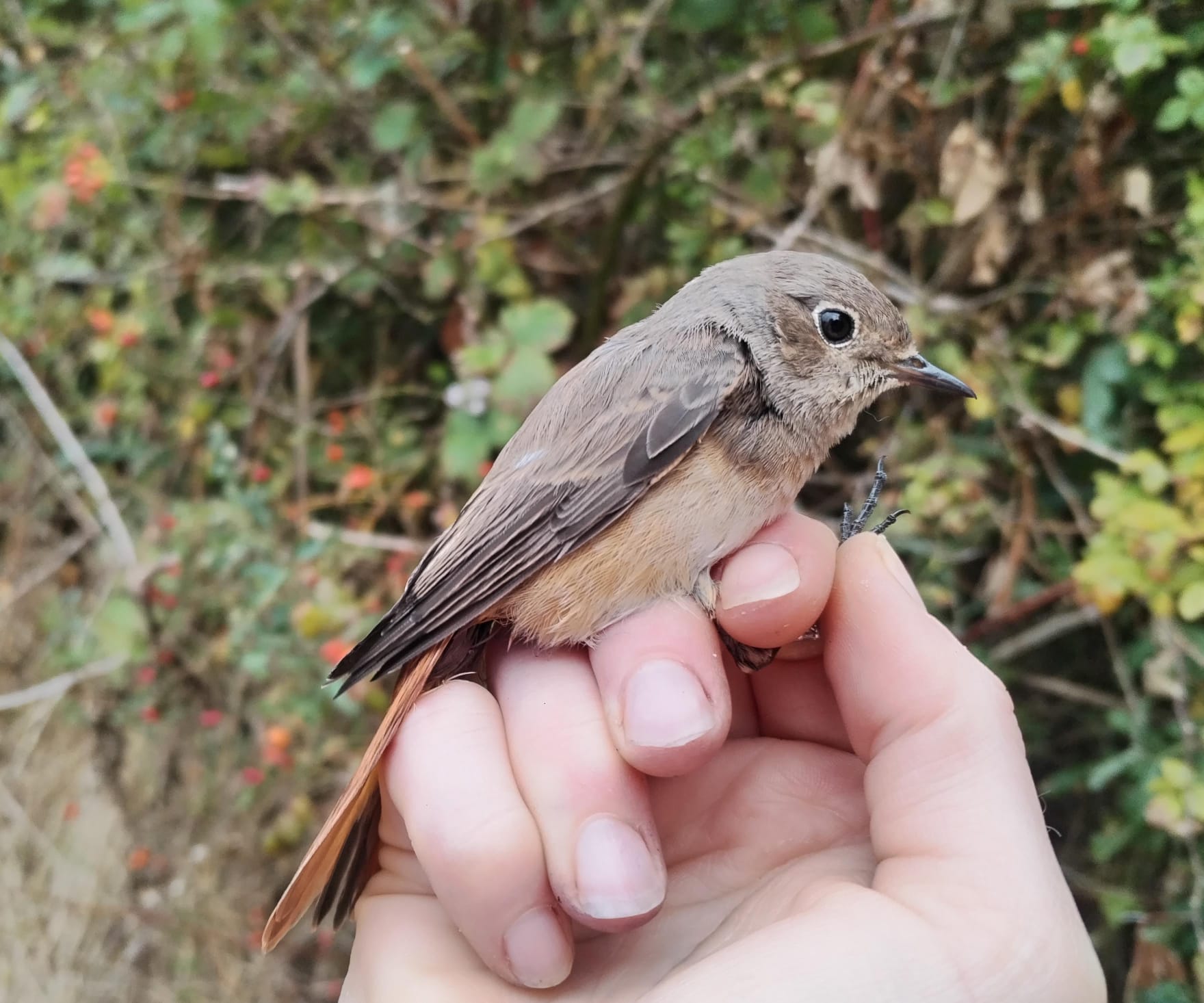
Common Redstart "Rødstjert"
Clouds and a bit of moisture in the air are good for getting moth Hans told me in the morning, indeed, I got two more species than yesterday, but it was not much. One new species for this period and again, also for me though, it was Hypena rostralis “Humleugle”, which I did not even collect from the trap but from inside the ringing lab. Soon, I will have more moths than bird species, which is not very difficult as there are way more moths than bird species so even if it was not many moths this period, I got quite some new, which makes checking the traps and walls varied and exciting every day, and you can discover real beauties among the moth.
Nevertheless, there might be fewer moths on the walls and in the blog of GFU from now on, I will leave tomorrow, but Larissa just told me, that she might continue, so I am sure she will let us know if there is something nice.
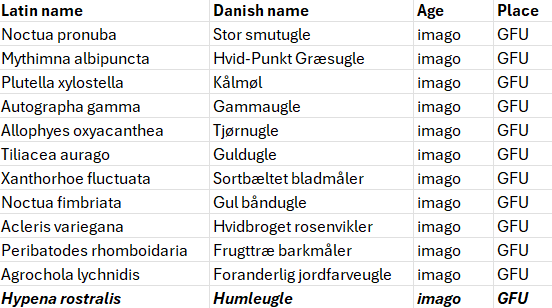
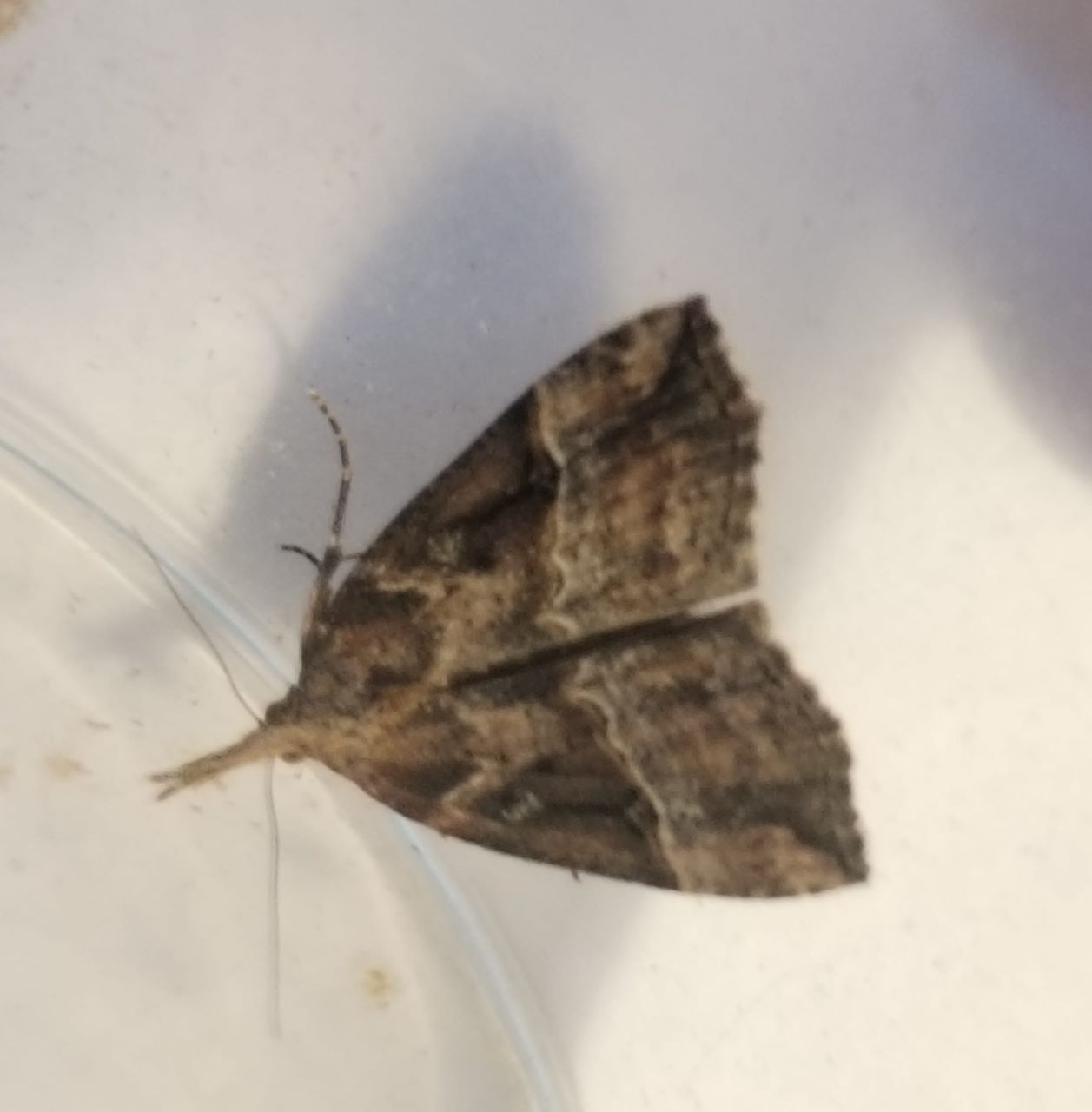
Hypena rostralis "Humleugle"
So again, a second farewell blog for GFU from me this year but there will be more entries from me on Blåvands blog until the end of the season. But hope to be back here next year, until then, take care!
Best regards, Hanelie
Migration at Gedser Odde by Larissa Britton: A relatively quiet morning at the tip, with a lot of mist which reduced visibility for periods this morning; 947 individuals, representing 27 species. This morning was my first solo migration count.
Despite not having Mads and Lara W to spend the morning with, several raptor species kept me company. Good views of a majestic Osprey/Fiskeørn (Pandion haliaetus) today, with one individual flying just metres away. I got a close look at its strongly hooked beak - a necessary tool for this piscivorous bird whose diet is made up of ~99% fish! Also flying close by: two Honey Buzzard/Hvepsevåge (Pernis apivorus), a Marsh Harrier/Rørhøg (Circus aeruginosus), Red Kite/Rød Glente (Milvus milvus), Kestrel/Tårnfalk (Falco tinnunculus), and Sparrowhawk/Spurvehøg (Accipiter nisus).
A small flock of Dark-bellied Brent/Knortegås (Branta bernicla bernicla) geese flew by later in the morning. I am familiar seeing Light-bellied Brent (Branta bernicla hrota) in Ireland, so it is nice seeing their Dark-bellied cousins here. A single Common Snipe/Dobbeltbekkasin (Gallinago gallinago) was seen this morning, too.
Gert joined me later in the morning, and we enjoyed watching Harbour Porpoise/Marsvin (Phocoena phocoena) and seals swimming and feeding quite close to shore.
As always, we shall see what tomorrow brings...
At the station: Hans Lind, Vagn Lind, Hanelie Sidhu, Lara Winsloe and Larissa Britton
Sommerlig dag med mange Gransangere
Så kom tiden, hvor brødrene Lind tog over efter Robert Luttik. Vi har glædet os længe til igen at ringmærke sammen . Jeg, Vagn Lind ringmærker jo en del på Fanø, hvor jeg året igennem har det hele for mig selv i Strandkrattet i Sønderho. Derfor er det altid en stor fornøjelse at komme til Gedser i efteråret, da der så er mulighed for sparring med andre ringmærkere. Man kan jo altid lære noget nyt og måske er der også nogen der kan lære noget af mig.
Da jeg mødte i går eftermiddag blev jeg modtaget af 3 unge mennesker, både en kendt og 2 ukendte og jeg er sikker på, at vi vil få 14 fornøjelige dage sammen.
Vi stod op til det mest pragtfulde vejr, ja, - måske lidt diset i de første morgentimer, men hurtigt kom solen og varmen frem. Vi valgte at glæde os over at svede lidt, da i dag nok bliver den sidste sommerlige dag i nogen tid.
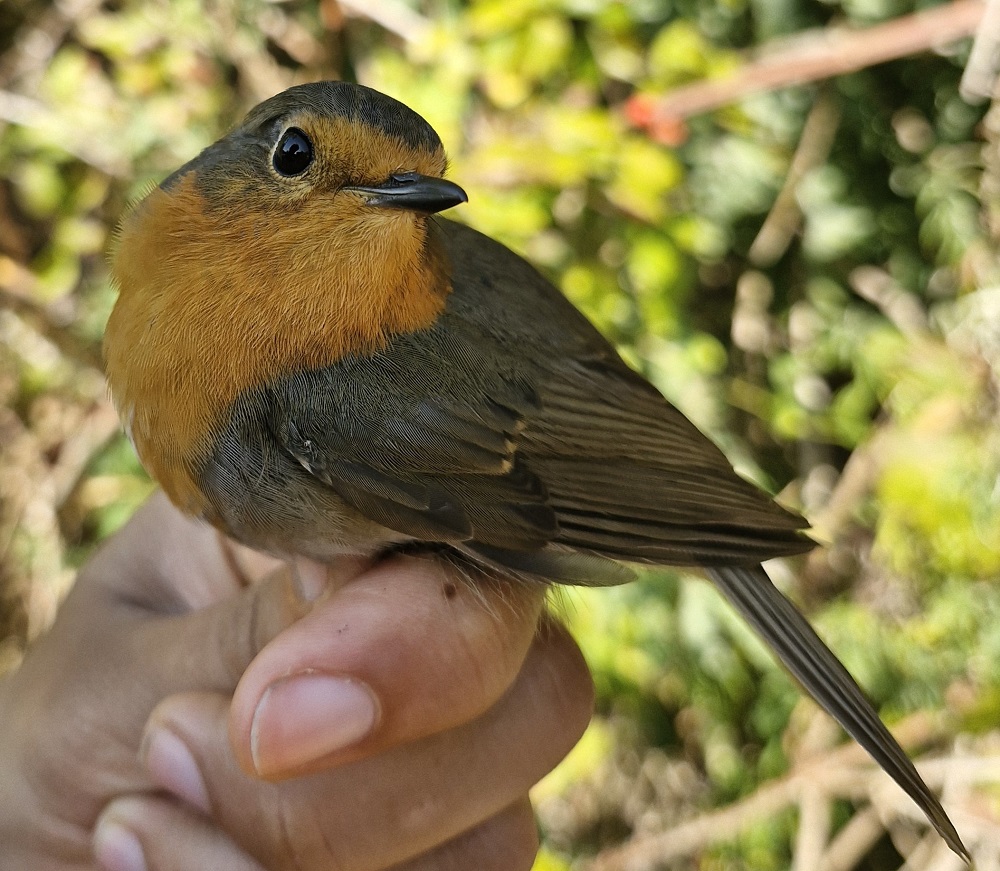 Rødhals
Rødhals
At dagen så trods alt skulle levere os over 100 nye fugle havde vi måske ikke regnet med.
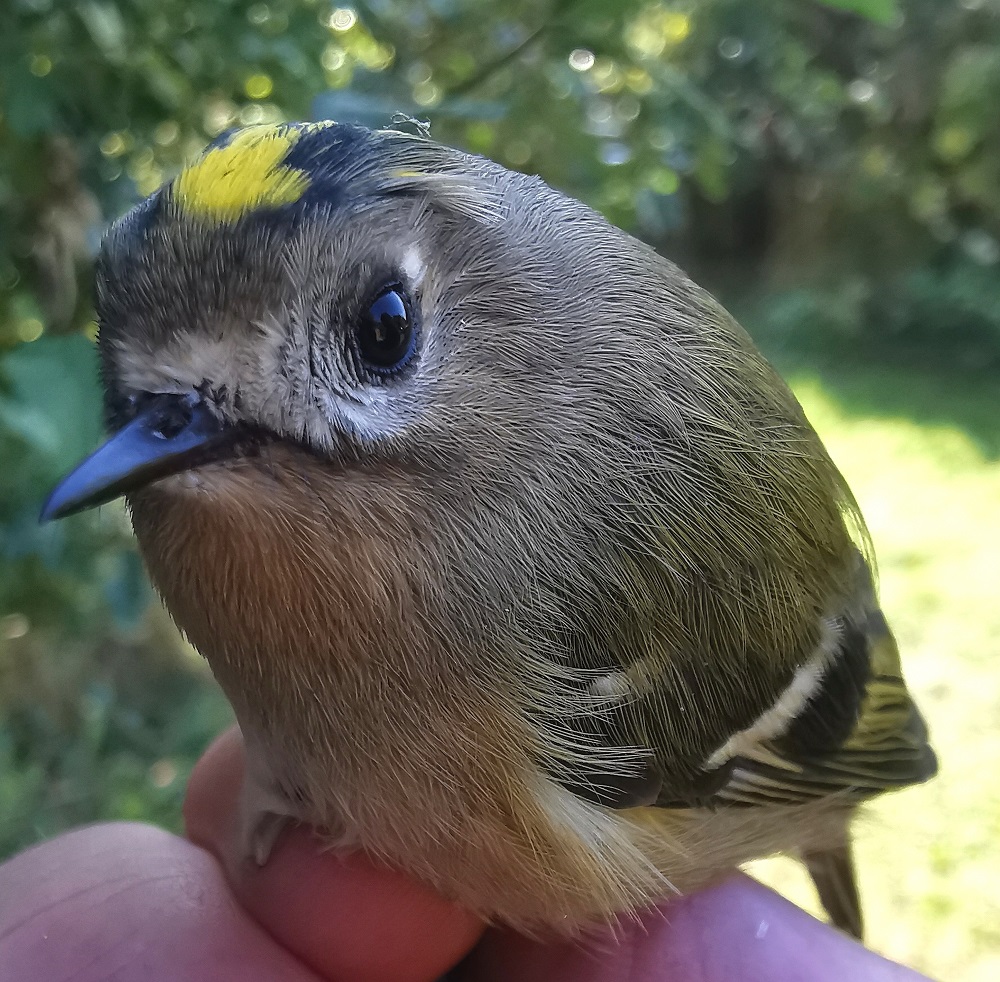 Fuglekonge
Fuglekonge
Ingen specielle arter. Dagen blev domineret af Gransangere. Vi havde en overgang så meget at lave, bl.a. også med at få Lara W i gang med mærkning, at vi ikke rigtig nåede at få taget så mange gode billeder.
Håber på det bliver bedre i morgen.
Dagens fangst:
The moth:
I did not find many moths in the traps and on the walls today; there were just 10 species, most of which I recognised from the days before. One that I picked from the wall after the opening round was new though. Both new for GFU for that period this autumn, that we are catching and also a new one for me: Agrochola lota “Pile-jordfarveugle”. Hans was again successful with Agrius convovuli “Snerlesværmer”, he had a few in his garden.
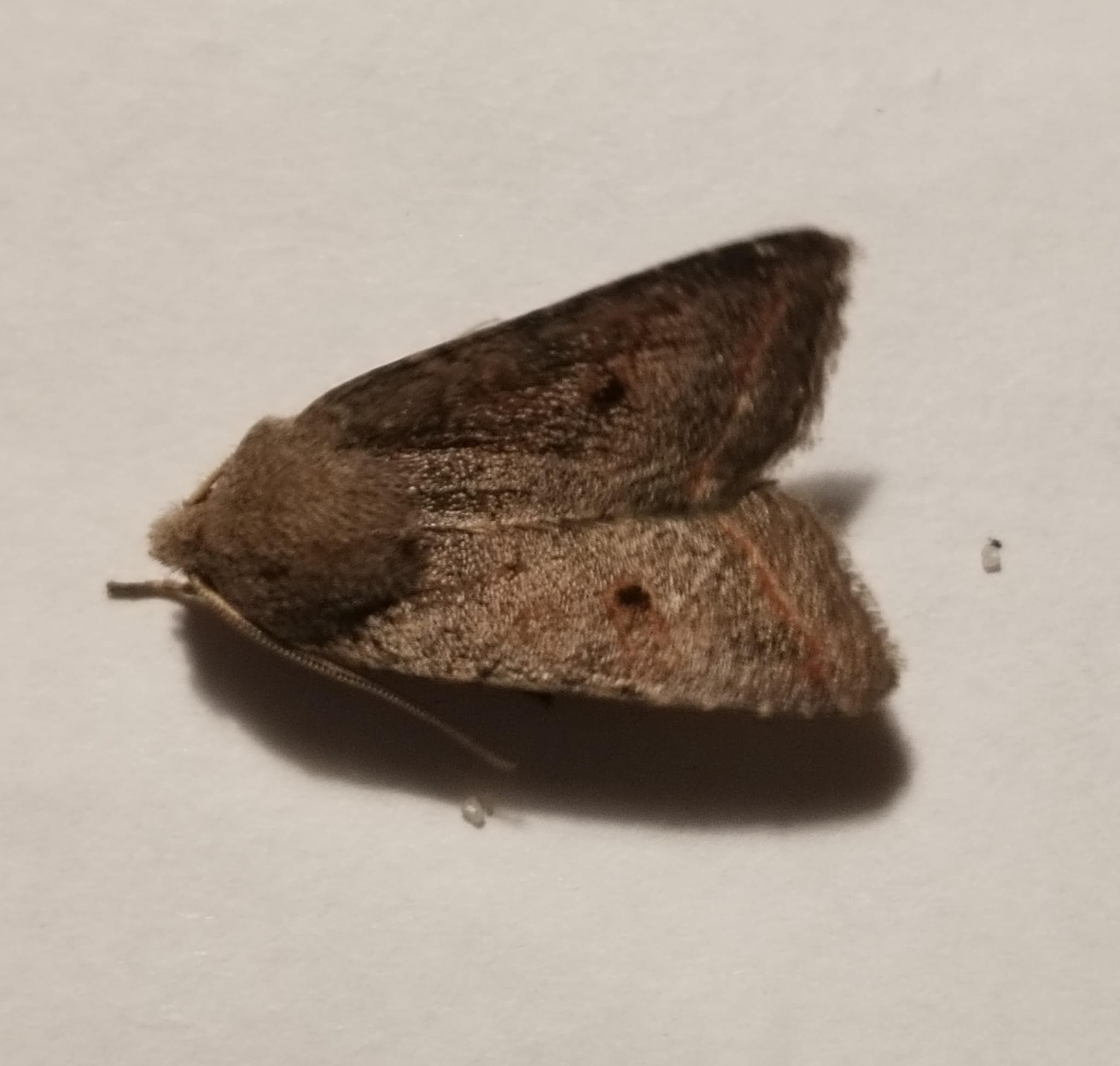
Leptologia lota "Pile-jordfarveugle"
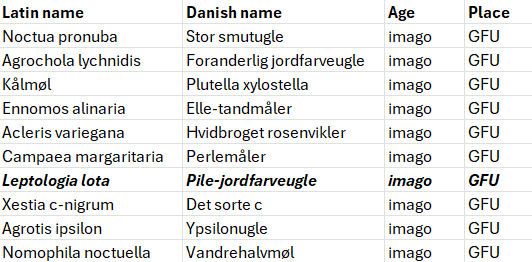
Migration at Gedser Odde by Larissa Britton: Yesterday was the Autumn Equinox, meaning today the days begin to get shorter and Autumn is upon us. 2768 birds today, representing a nice diversity of 38 species. Here is a rundown of the species we had the pleasure of seeing today at the tip:
Excitement early this morning when an Osprey/Fiskeørn (Pandion haliaetus) was observed. I have been told to expect more Ospreys over the next coming weeks, so I look forward to seeing more of these beautiful raptors.
Still a few Hirundinidae leaving us for warmer Africa, with a small number of Barn Swallow/Landsvale (Hirundo rustica), House Martin/Bysvale (Delichon urbicum), and Sand Martin/Digesvale (Riparia riparia) counted today.
Several wader species were spotted today, these include: Oystercatcher/Strandskade (Haematopus ostralegus), Spotted Redshank/Sortklire (Tringa erythropus), Dunlin/Almindelig Ryle (Calidris alpina), and a Golden Plover/Hjejle (Pluvialis apricaria) which was heard first with its characteristic flat whistle.
As for gulls, today we had Black-headed/Hættemåge (Larus ridibundus), Common/Stormmåge (Larus canus), Herring/Sølvmåge (Larus argenteus), and 14 Little gulls/Dværgmåge (Hydrocoloeus minutus). We also watched two juv Great Black-backed gulls/Svartbar (Larus marinus) feeding.
Finally, though not migrating, a Black Guillemot/Tejst (Cepphus grylle) was spotted out at sea today.
Tomorrow, I will be back with an update for the migration count. Rain is forecast, but we will have to wait and see what conditions, and birds, will be met. I will be armed with my raincoat and some warming ginger tea. :)
At the station Hans Lind, Vagn Lind, Hanelie Sidhu, Lara Winsloe and Larissa Britton
The night of the Måler
This morning Robert and I opened the nets together one last time this autumn, from tomorrow on, the ringing team will change a bit. In the first rounds, we were joined by Amanda and Adam from DOF ung. The first rounds were quite slow, the morning was also a bit foggy. Adam ringed a partially leucistic female Blackcap “Munk” which was white on the wing feathers (see picture).
Between these slow rounds, Robert and I had time to check the moth traps, after Robert left home but was so kind to do the moth table and “moth part” of the blog from home.
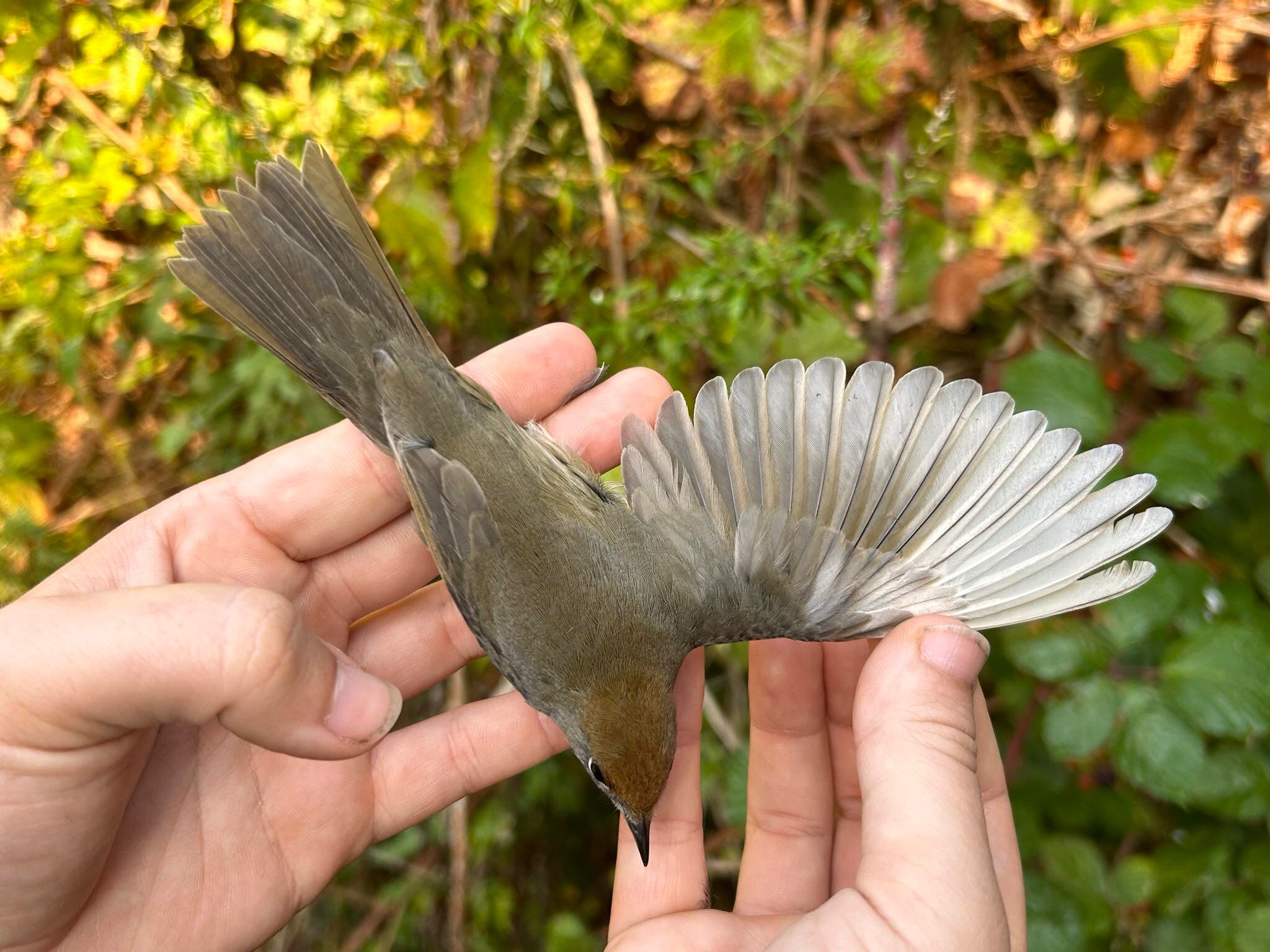
I had said yesterday that it was my last blog, but we caught a few nice moths (see table) and had 5 different Måler species, of which two were new for the season (bold ones in Table), and one was new for me and Hanelie and a lot of other persons that were present at the station (DOF ung). It is the Vandremåler (in English the Gem Moth). In Naturbasen there are now only 7 entries. It is a species of continental Europe and can fly considerable distances over water. It is a relatively rare species in in the north of Europe.
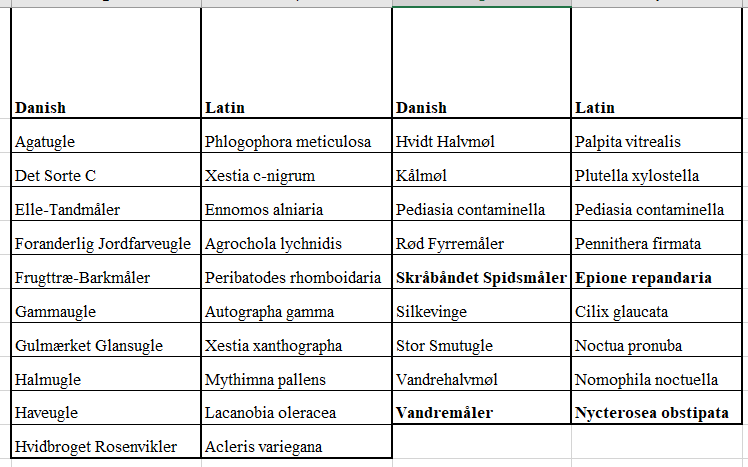
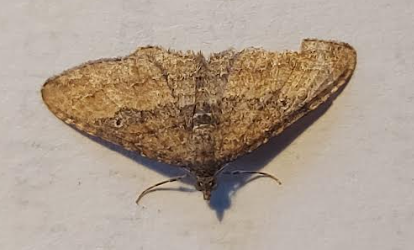
Vandremåler (Gem Moth)
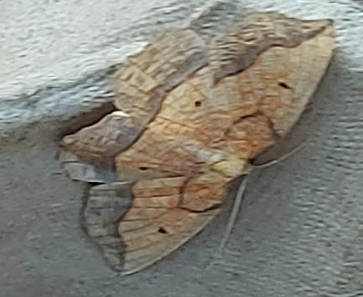
Skråbåndet Spidsmåler (Bordered Beauty)
Migration Count at Gedser Odde
by Lara W
Migration is definitely picking up speed! Overall numbers are increasing daily, with just short of 5800 counted at the tip over the course of the morning, representing 45 species. The vast majority of these were Wigeon/Pibeand (Anas Penelope), flocks of which often passed high up above our heads as they flew south. Up until now, they have tended toward flying out at sea, but today there was a distinct change in behaviour, as many of the birds flew over land. This may have been due to the heavy sea mist present until around 0800, reducing our visibility at one stage to around 100m. It cleared fairly quickly, but whilst all about us, the mist garnered a beautiful sense of calm quiet. Flocks of ducks could just be seen flashing in-between the clouds of mist floating above the water, but were all too quickly swallowed up in the fog.
Photo credit: Lara W
Once the fog had cleared, the sun came out to shine on an almost continual stream of bird-traffic out on the water. As stated above, wigeon numbers were highest, at 3417, followed by 775 Teal/Krikand (Anas crecca), 598 Common scoter/Sortand (Melanitta nigra), and 537 Common Eider/Ederfugl (Somateria mollissima). 94 Pintail/Spidsand (Anas acuta) and 40 Shoveler/Skeand (Anas clypeata) were spotted in mixed flocks, most often with the wigeon, along with a few surprises: 1 Tufted Duck/Troldand (Aythya fuligula), 1 Goldeneye/Hvinand (Bucephala clangula), and a single Common Snipe/Dobbeltbekkasin (Gallinago gallinago). This last looked rather incongruous flapping in its usual brisk manner, trailing behind a group of the much larger eiders.
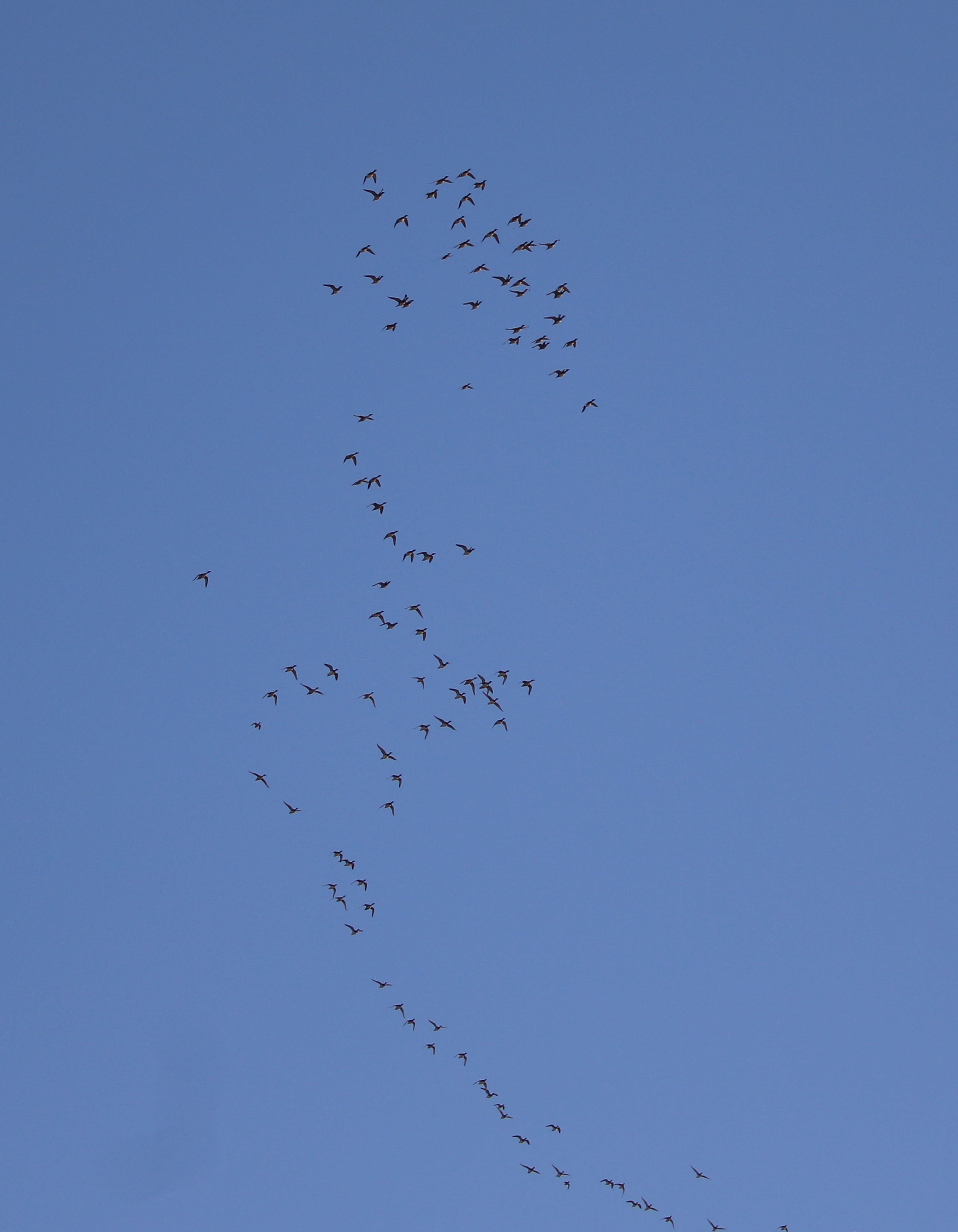
Mixed flock, majority Wigeon, photo credit: Lara W
2 Red-throated Diver/Rødstrubet Lom (Gavia stellata), and 1 Black-throated Diver/Sortstrubet Lom (Gavia arctica) were spotted, with a Red-throat passing right over our heads, allowing a close-up view of this beautiful bird. Further out to sea, 36 Sandwich tern/Splitterne (Thalasseus sandvicensis), 4 Little gull/Dværgmåge (Hydrocoloeus minutus) and one Common gull/Stormmåge (Larus canus) were counted passing south-west. There was very little time to observe behaviours in-between counting the migrating birds, but occasionally I did manage to sneak a glance at foraging terns, loafing eider, and a few larger Herring gull/Sølvmåge (Larus argenteus) attempting to steal food from their smaller cousins – always fun to watch!
Rising up from behind us were a number of raptors and passerines embarking on their migration. This included 32 Starling/Stær (Sturnus vulgaris), 28 White wagtail/Hvid Vipstjert (Motacilla alba), and 18 Chaffinch/Bogfinke (Fringilla coelebs), 30 Sparrowhawk/Spurvehøg (Accipiter nisus), 7 Kestrel/Tårnfalk (Falco tinnunculus), 2 Merlin/Dværgfalk (Falco columbarius), and a single Hobby/Lærkefalk (Falco subbuteo). Of the larger birds of prey, 4 Honey Buzzard/Hvepsevåge (Pernis apivorus) and a single Marsh Harrier/Rørhøg (Circus aeruginosus) were seen. The real excitement came when an Osprey/Fiskeørn (Pandio haliaetus) was spotted far back up the coastline. Winging its way on sure, steady wingbeats, this wonderfully striking bird truly captured our attention, with its prominent sharp bill and stunning white head and collar markings. Looking at the photos I hastily managed to capture, I believe the bird was an adult based on the lack of white markings on the upperparts of the wing and a couple of other features, but it was too far distant to be certain. A second Osprey was spotted crossing the coastline above the harbour to the west, but sadly was just out of the standard migration count time.
A fabulous day, thank you to all who helped with the counting and enthusiastically drew our attention to passing birds!
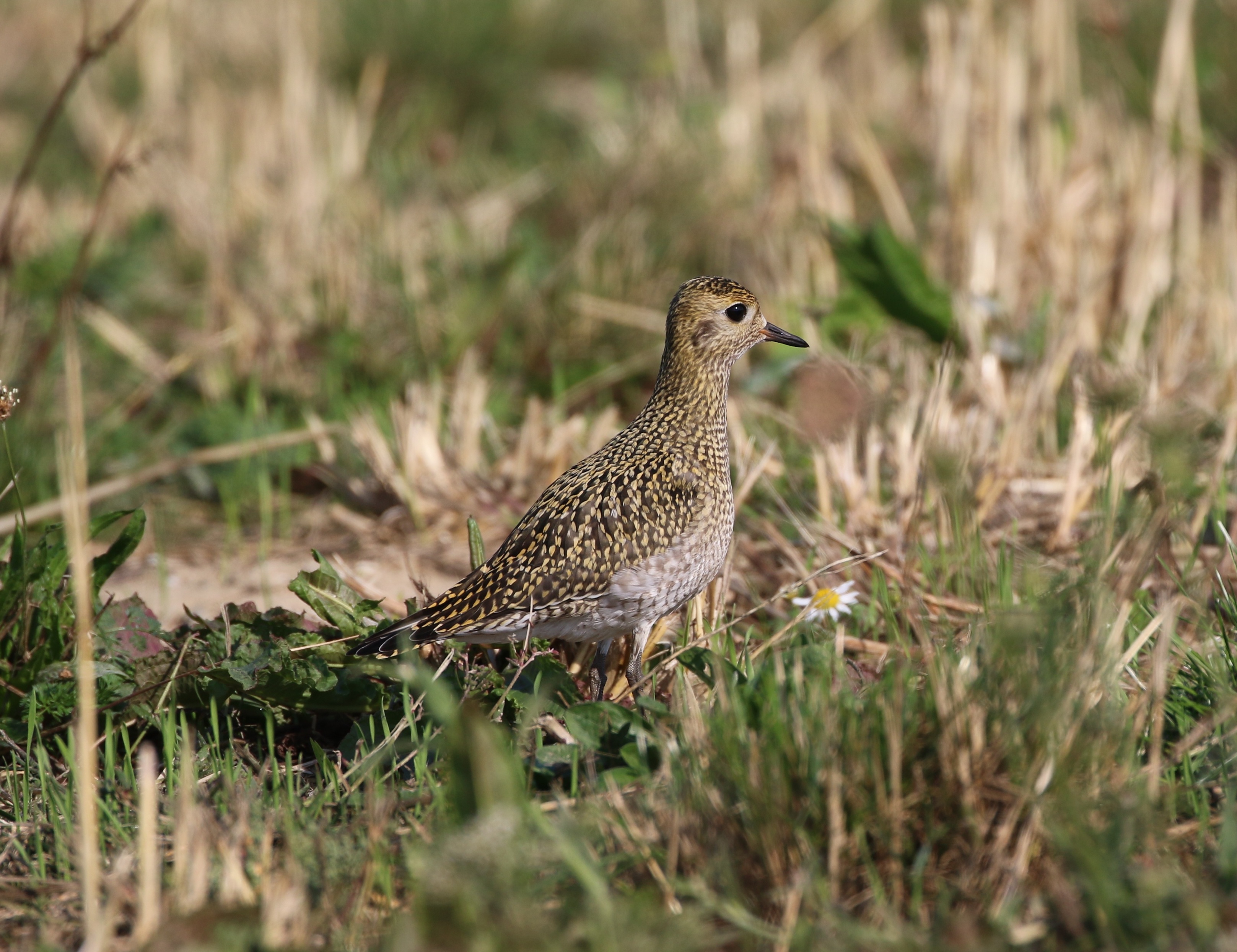
Golden Plover/Hjejle (Pluvialis apricaria), photo credit: Lara W
At the station; Hanelie Sidhu, Robert Luttik, Vagn Lind, Lara Winsloe, Larissa Britton and DOF ung
A guest from Sweden
This morning, we were joined for the first rounds by Armanda, Lise and Adam who are here with some others for a meeting from DOF ung. But unless the last days, we had very few birds in the first round. The second was a bit better but we just caught 40 birds in total today and recaptured 27 of them. But one was nice, it was a recapture of a first calendar year Chiffchaff “Gransanger” but with a Swedish ring!
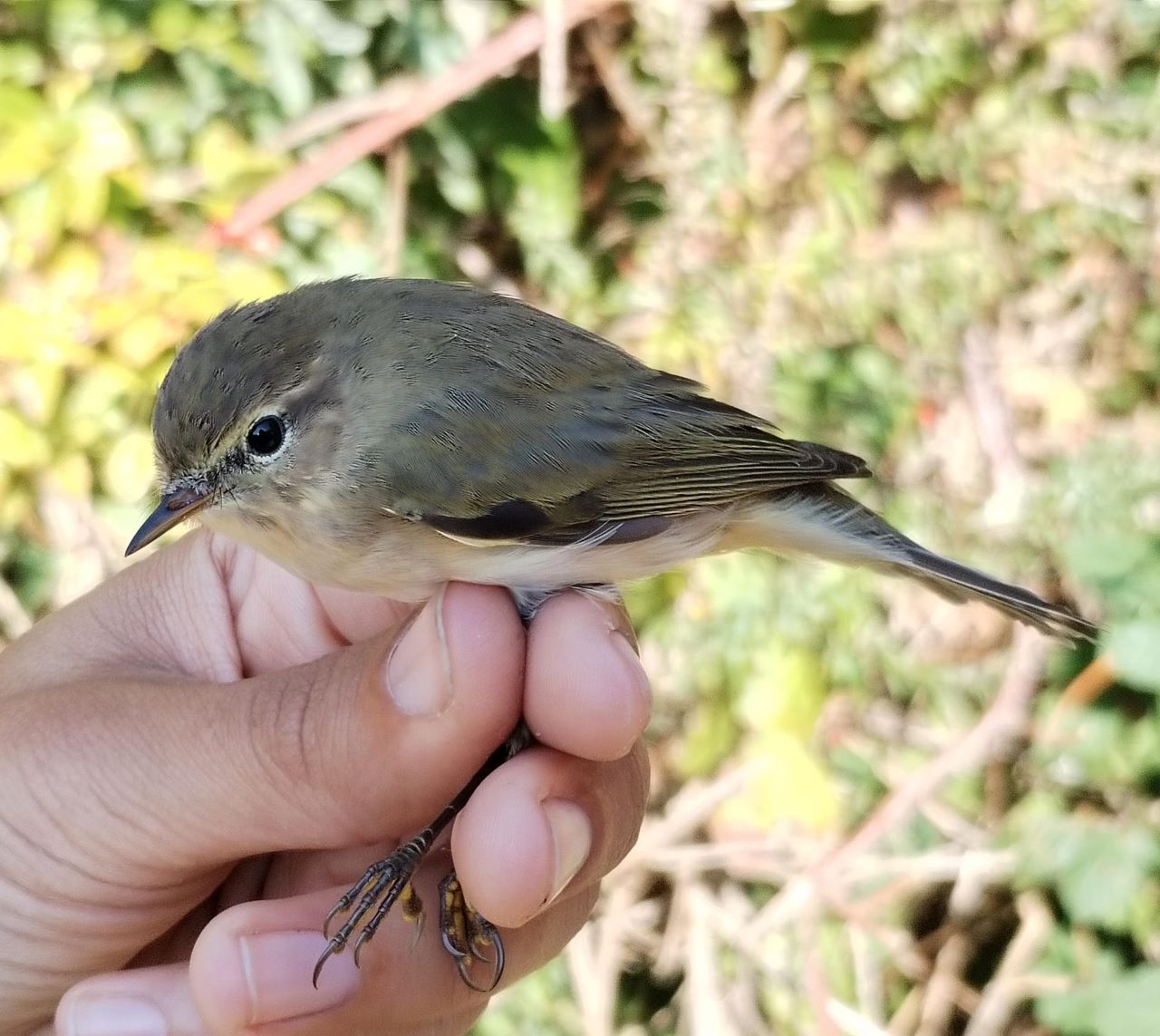
This will be the last contribution of me this year (hope to be back in May 2025). We did catch 18 moth species (see Table). I have added a nice yellow moth under the table. I think I have showed it before, but it is one of the beauties of the night.
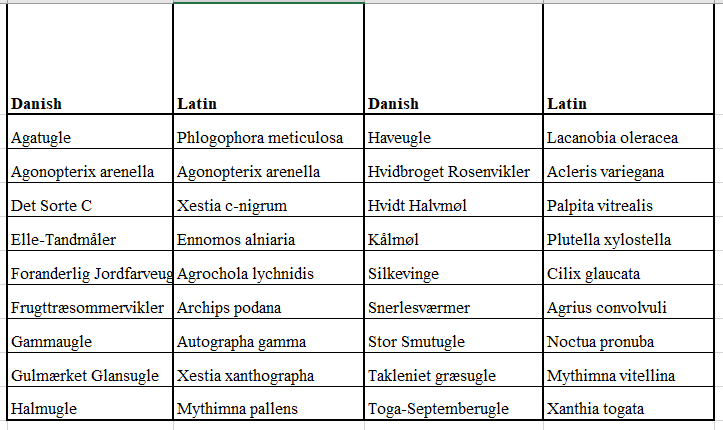

Elle Tandmåler (Canary-shouldered Thorn)
We had this morning a little moth of which I am not 100% sure what it is. It is probably either the Grøn Egevintervikler (Acleris literana, no English name) or Acleris rhombana (no Danish name). In English this one is called Rhomboid Tortrix.
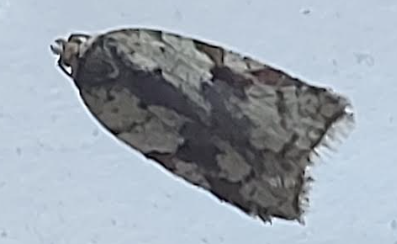
Migration at Gedser Odde: Yet another fair day at the tip, with clear, sunny skies and some haze on the horizon. A calm sea. A small dip in numbers today compared to previous, with just over 1000 individuals recorded in total, representing 30 species. Now, for the highlights.
The Nutcracker/Nøddekrige (Nucifraga caryocatactes) gave us some more good views today, and stirred excitement in the group. This bird was a lifer for some of the birders at the tip - always a memorable experience.
A lifer for me today too, with a Red-throated Pipit/Rødstrubet Piber (Anthus cervinus), which called with a slightly descending "zziiiieeet" call - almost like a combination of Meadow Pipit/Engpiber (Anthus pratensis) and Tree Pipit/Skovpiber (Anthus trivialis) calls. Meadow and Tree Pipits were also recorded today, along with flocks of Linnet/Tornirisk (Linaria cannabina) and of Chaffinch/Bogfinke (Fringilla coelebs).
Three Black-throated Divers/Sortstrubet Lom (Gavia arctica) crossed our path today - always special to see. Additionally, a group of three Dark-bellied Brent/Knortegås (Branta bernicla) flew over, a nice small species of goose. A Great Crested Grebe/Toppet Lappedykker (Podiceps cristatus) was also spotted, with its distinctively elongated neck and appearance.
My gull identification journey is underway and continues: we were charmed by the elegant flight of several Little Gulls/Dværgmåge (Hydrocoloeus minutus) today. I feel much more confident in my ability to identify this species (mange tak, Mads!) In particular, the nature of their flight, slightly rounded wings, and dark underwing, are good identifiers.
Even on days with smaller numbers, there is joy to be had in each species you encounter, be that a rarity or a common resident. Tak fordi du læste med :) By Larissa Britton.
At the station Hanelie Sidhu, Robert Luttik, Lara Winsloe and Larissa Britton and DOF ung
A little problem with a red-backed Shrike
Today we caught a Red-backed Shrike (Rødrygget Tonskade). I always check the books when catching something less common, so I will not make a mistake. In this case I used the Identification guide to birds in the hand of Laurent Demongin. And by comparing the wing formula I was a bit confused. The wing formula was pointing to Lanius senator (Woodchat Shrike). See the wing formula in the picture and compare it with the picture of the book. P2 is certainly much smaller than P3 and P4 and slightly shorter than P5. Did I catch a senator? No probably not. The T6 outer tail feather should have a broad pale tip for senator but only a narrow whitish edge for collurio (the Red-backed Shrike) and that was not the case. Overall, we decided that we had a Red-backed instead of a Woodchat.
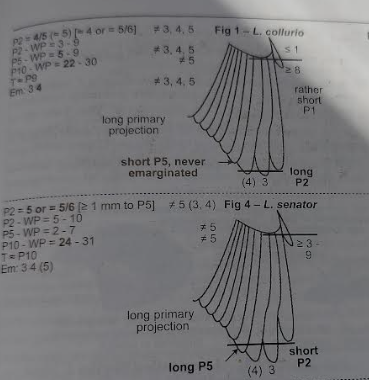
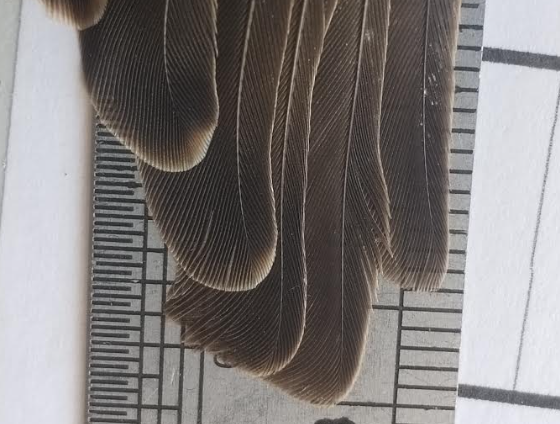
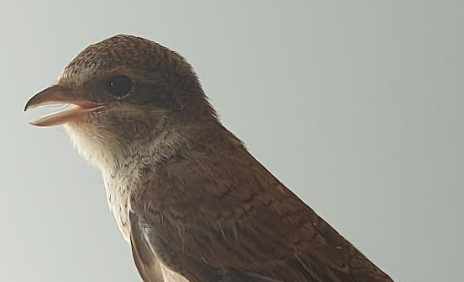

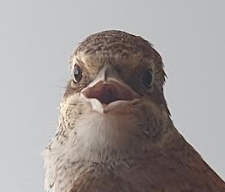
We had 22 species of moth (see table) and only 1 new one. It is a very strange looking moth when it is not flying. It is called the Chinese Character (Silkevinge, see picture).
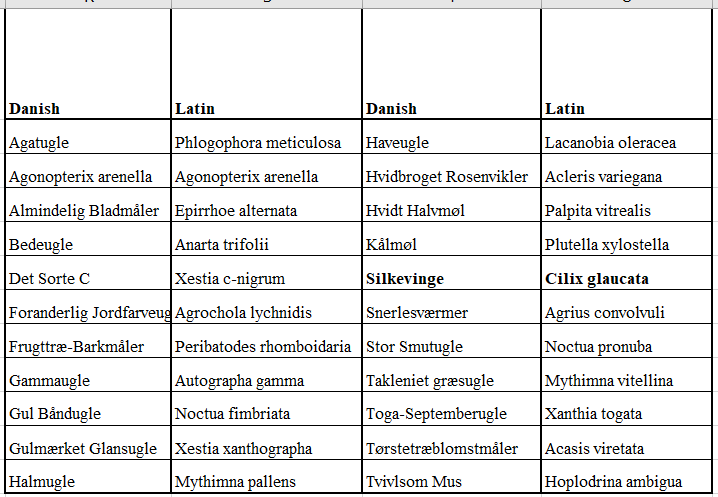
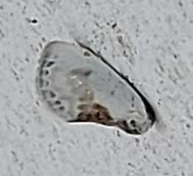
Migration Counts at Gedser Odde
by Lara W
A slightly slower day today in terms of numbers, and yet quite a bit of excitement closer to home! But more on that in a moment…the highest number spot was once again claimed by the Common Eider/Ederfugl (Somateria mollissima), with 1035 individuals passing the point. Although sunny, there was quite a haze over the sea which may have impacted visibility. As it was, only 170 Wigeon/Pibeand (Anas Penelope) and 50 Common scoter/Sortand (Melanitta nigra) were counted, which over the last few days have been spotted migrating into the hundreds. Coming in mixed flocks, 10 Pintail/Spidsand (Anas acuta), 27 Teal/Krikand (Anas crecca), and 4 Shoveler/Skeand (Anas clypeata) were also seen, along with 9 Red-breasted Merganser/ Toppet Skallesluger (Mergus serrator). Other seabirds passing included 14 Sandwich tern/Splitterne (Thalasseus sandvicensis), 8 Little gull/Dværgmåge (Hydrocoloeus minutus), 1 Common tern/Fjordterne (Sterna hirundo), and 7 Velvet Scoter/Fløjlsand (Melannita fusca).
Flying out from behind us were a variety of near-passerines and raptors, including 15 Stock Dove/Huldue (Columba oenas), 2 Hen Harrier/Blå Kærhøg (Circus cyaneus), 4 Kestrel/Tårnfalk (Falco tinnunculus), a Merlin/Dværgfalk (Falco columbarius), and 38 Sparrowhawk/Spurvehøg (Accipiter nisus). Two events had us all in real excitement – the return of the Nutcracker/Nøddekrige (Nucifraga caryocatactes), and a juvenile skua which stayed grounded on the field for at least two hours. Addressing the nutcracker first – we believe this to be the same individual that has been returning to the area around the fuglestation for the last 6 weeks. This was confirmed when Mads Elley spotted the bird had been ringmarked when it (finally) perched on a nearby tree. As before, the bird approached the cliffs several times, only to turn back at the last moment. Theories are flying about as to why a bird, which is known not to migrate until mid-October, would be instigating such behaviour, but as yet, nothing is confirmed. Feel free to comment your thoughts!
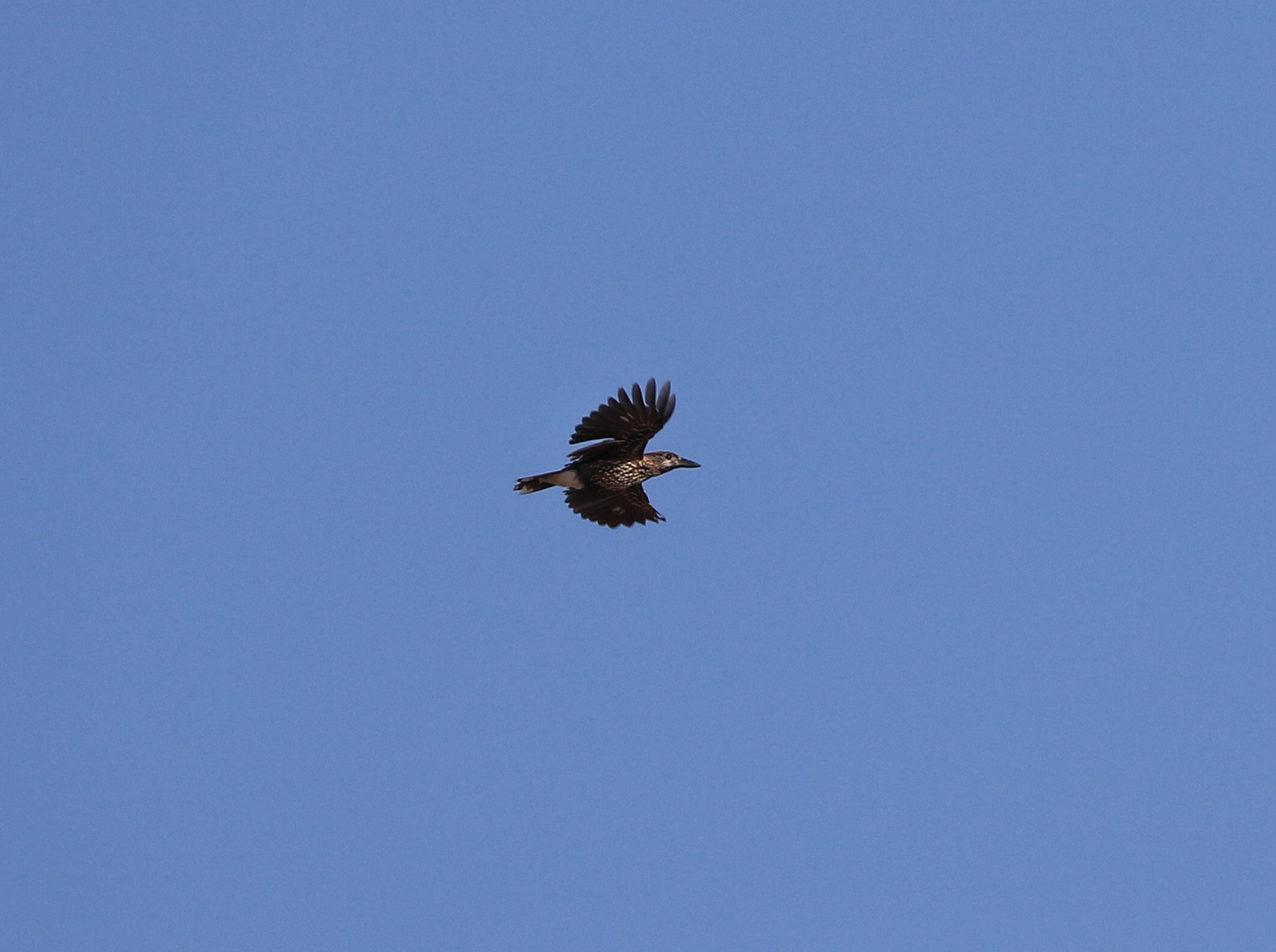
The skua which elicited such attention lay grounded for some time in the fields, preening, and eventually flushed by a passing Red Kite/Rød Glente (Milvus milvus). Some conversation was held over the correct identification of the bird, as it exhibited features of both long-tailed and arctic, but eventually, the long-tailed/Lille Kjove (Stercorarius longicaudus) crew bore out. Whatever the case, it was an absolutely stunning bird to get up close and personal with.
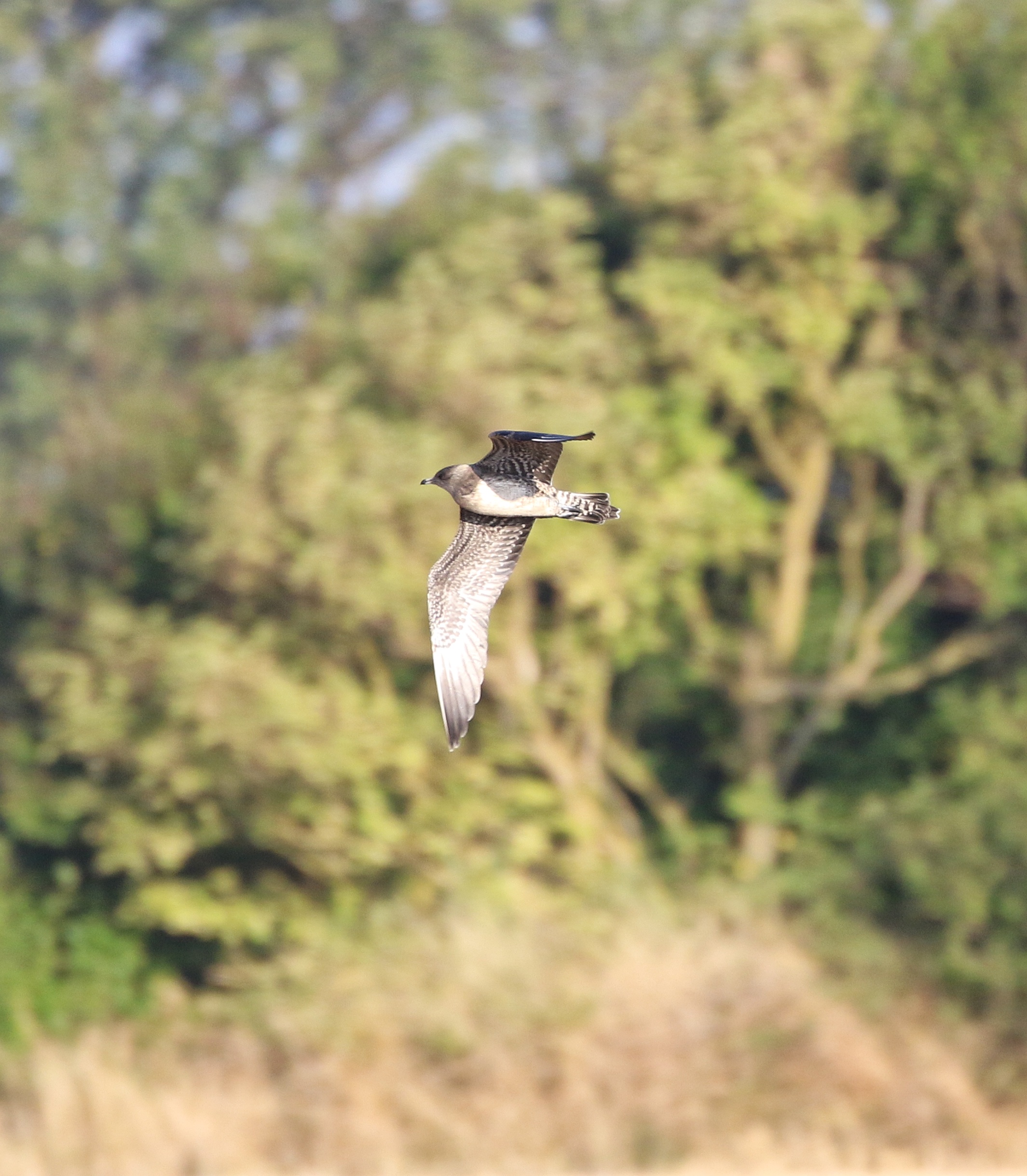
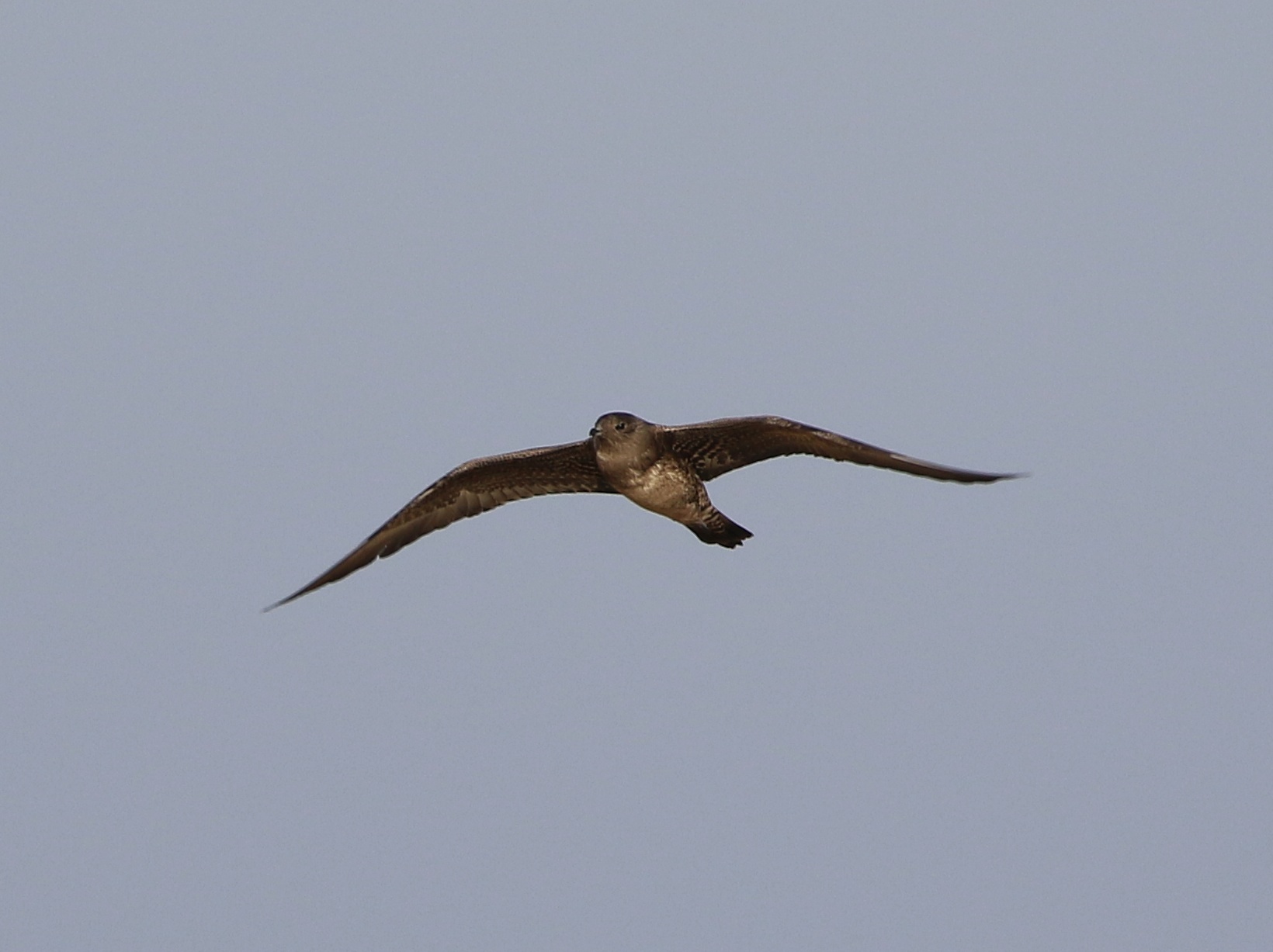
Photo credits: Lara W
In terms of passerines, we had similar species migrating as before, including 13 Swallow/Landsvale (Hirundo rustica, 2 House martin/Bysvale (Delichon urbicum), 132 White wagtail/Hvid Vipstjert (Motacilla alba), 42 Chaffinch/Bogfinke (Fringilla coelebs), and 29 Linnet/Tornirisk (Linaria cannabina).
In other news, DOF UNG group (Danish Ornithological Youth Group) is visiting this weekend, as part of planning their annual activities to encourage younger people to become engaged in nature. This weekend, 11 people will be participating in both the migratory counts and ring marking. Several within the group already hold a ringing licence and have visited Gedser Fuglestation before, so will be able to help teach others without such experience. The group will also be taking the time to not only soak up the relaxed atmosphere in Gedser, but also plan the next year’s activities.
At the station: Hanelie Sidhu, Robert Luttik, Lara Winsloe and Larissa Britton
Frosted Orange (Burreugle)
Again, this morning, we caught mostly Robins “Rødhals” and Chiffchaffs “Gransanger” but it was way less busy as yesterday, we did not reach the 100 today. Recaptures made a lot of our numbers today, we had 30! So there was not so much import of new birds today, but we got some more Goldcrests “Fuglekonge” and Wrens “Gærdesmutte” than the days before.
In the night we did catch 27 species of moths. Four were new for the season (see bold names in the table below). This time only one picture of a moth with the funny name Frosted Orange (Burreugle).
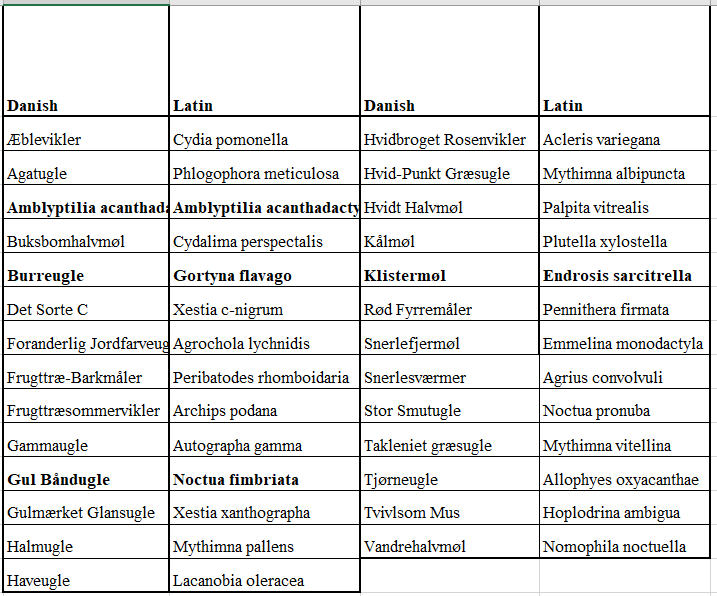
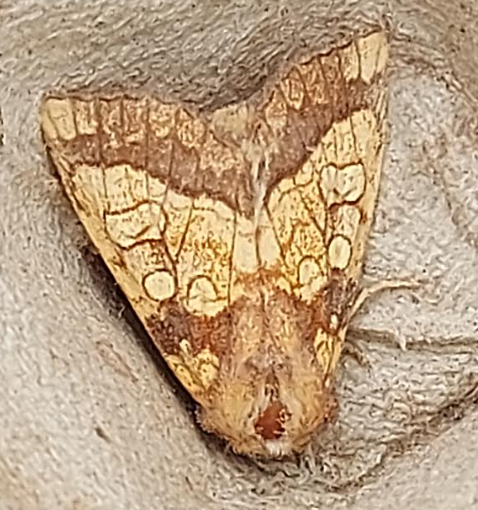
Frosted Orange (Burreugle)
Migration counts at Gedser Odde
by Lara W
19th September marks the highest numbers for autumn migration so far this season! A total of 5229 individuals were counted passing Gedser Odde. Common Eider/Ederfugl (Somateria mollissima) accounted for the majority, although only 66 of the 2122 overall were of “female-type/Hun-farvet” plumage. We use this term as both females and juveniles of both sexes have extremely similar plumages and therefore are generally indistinguishable, especially in flight. It is noteworthy that so few of the Eiders passing us are potentially females, as it carries implications for breeding success and reproduction rate.
Common eider on migration, photo credit Lara W.
Wigeon/Pibeand (Anas Penelope) and Common scoter/Sortand (Melanitta nigra) were also seen in high numbers, at 1134 and 1176 respectively. Several other duck species less commonly seen were spotted, including Tufted Duck/Troldand (Aythya fuligula) (2), Goldeneye/Hvinand (Bucephala clangula) (1), Gadwall/Knarand (Anas strepera) (18), and Pochard/Taffeland (Aythya farina) (1). Other surprises included 10 Stock Dove/Huldue (Columba oenas), 1 Golden Plover/Hjejle (Pluvialis apricaria), 1 Arctic skua/Almindelig Kjove (Stercorarius parasiticus), and 2 Whimbrel/Småspove (Numenius phaeopus). For passerines, 107 Swallow/Landsvale (Hirundo rustica), 64 White wagtail/Hvid Vipstjert (Motacilla alba), and 4 Meadow pipit/Engpiber (Anthus pratensis) were seen migrating. Noteworthy were 55 Chaffinch/Bogfinke (Fringilla coelebs) (2), Tree Pipit/Skovpiber (Anthus trivialis), and a single Siskin/Grønsisken (Spinus spinus).
People: Lara Winsloe, Larissa Britton, Robert Luttik, Hanelie Sidhu
